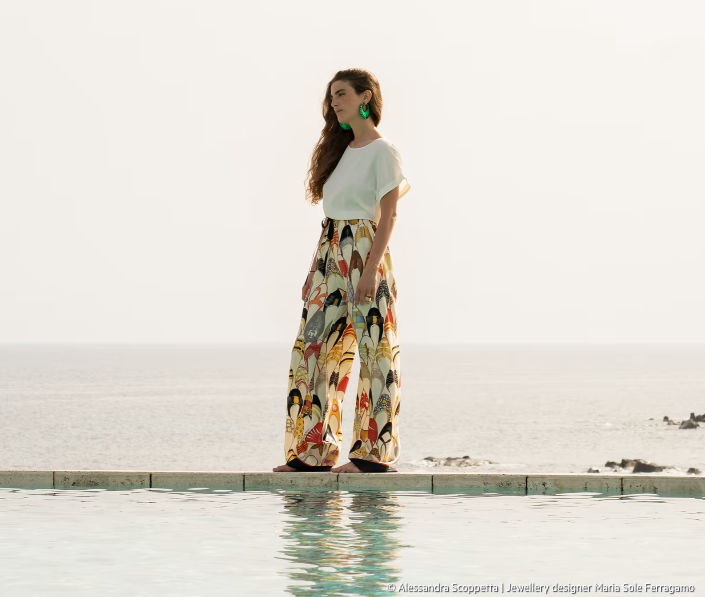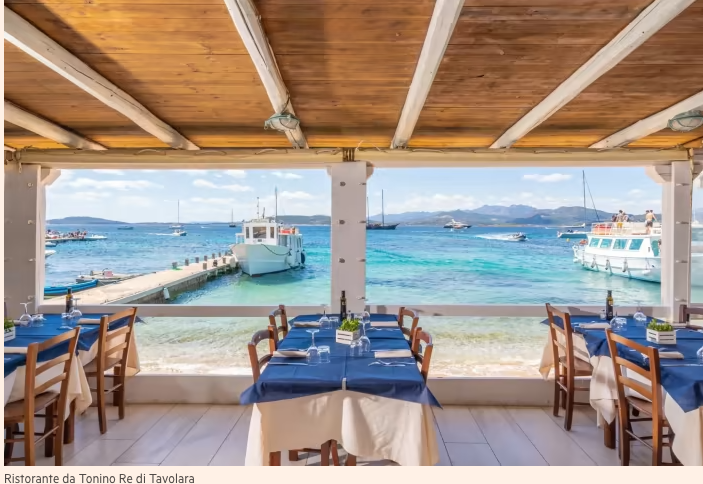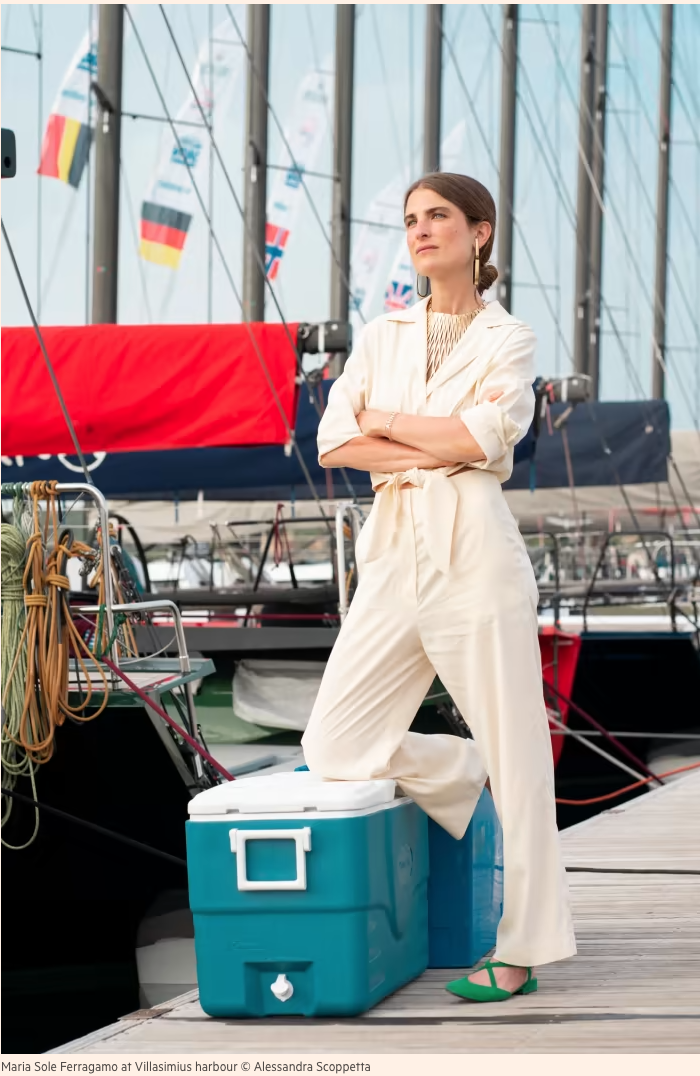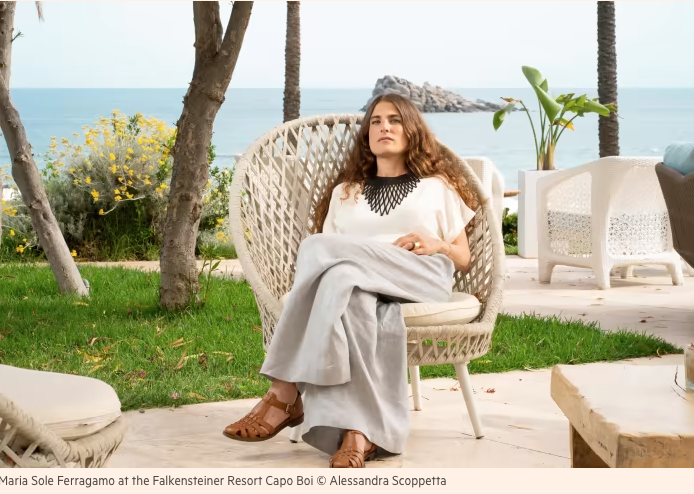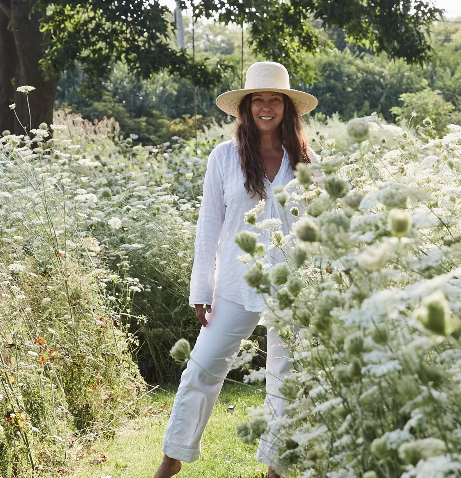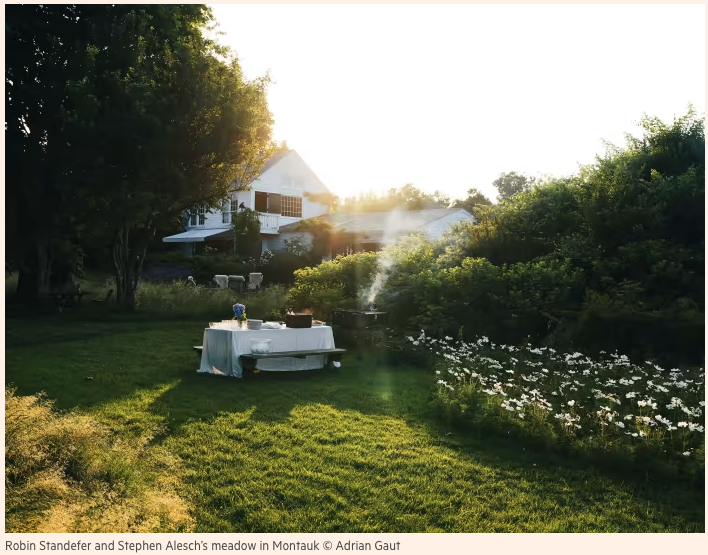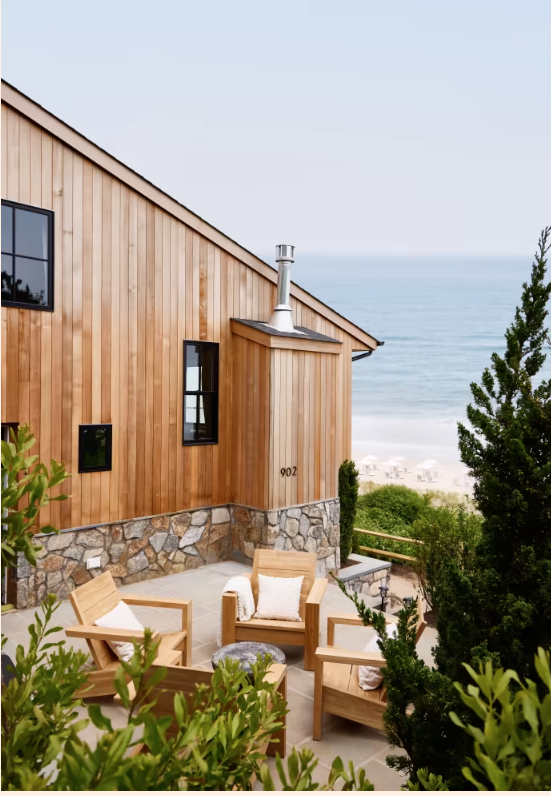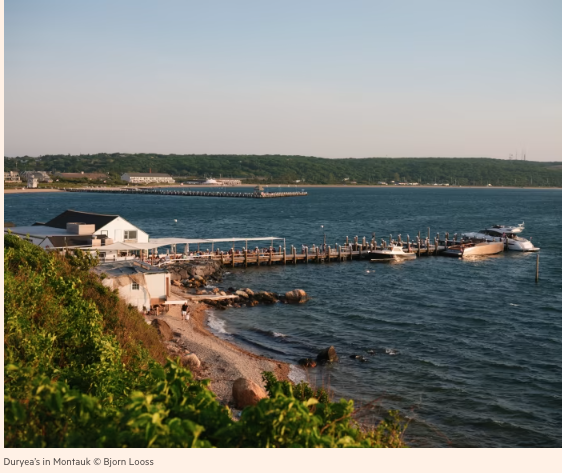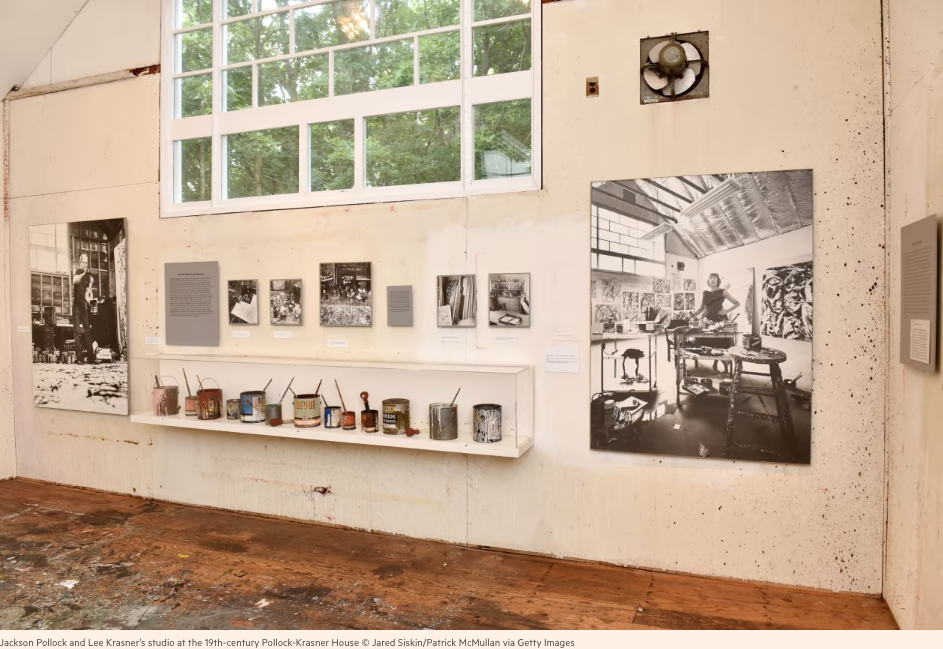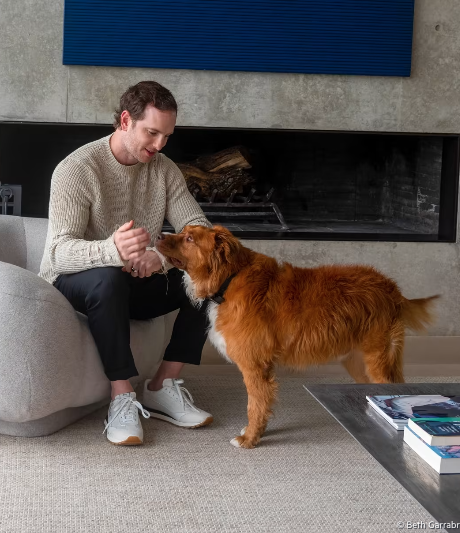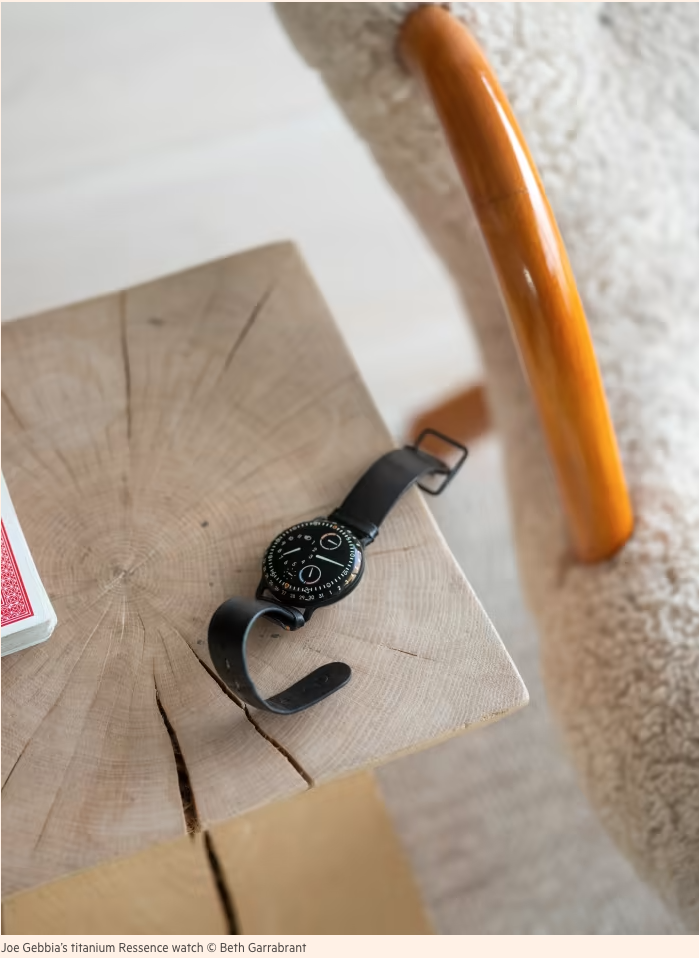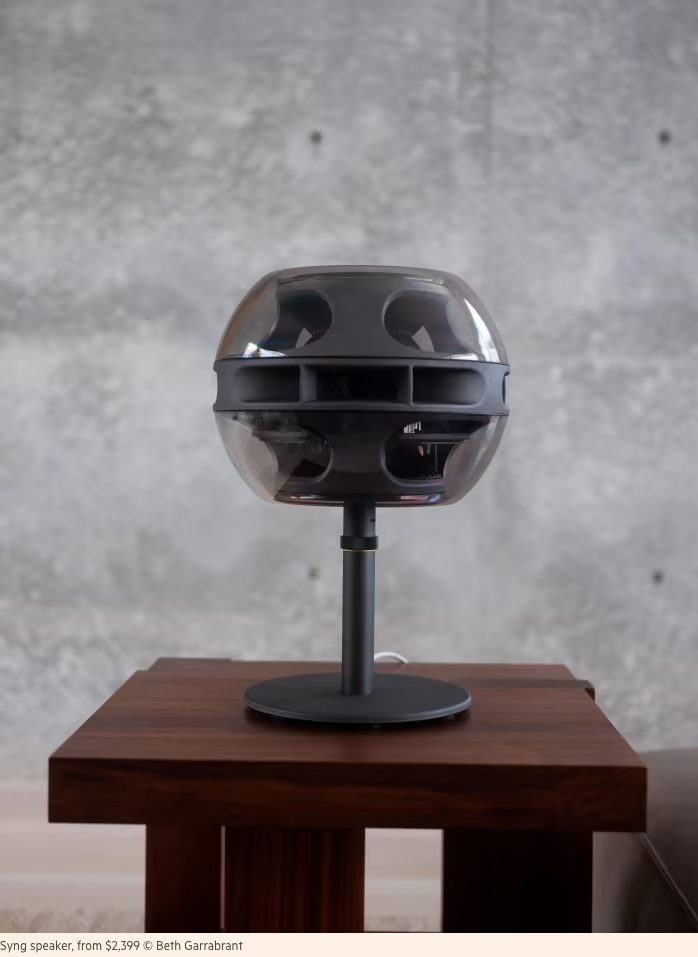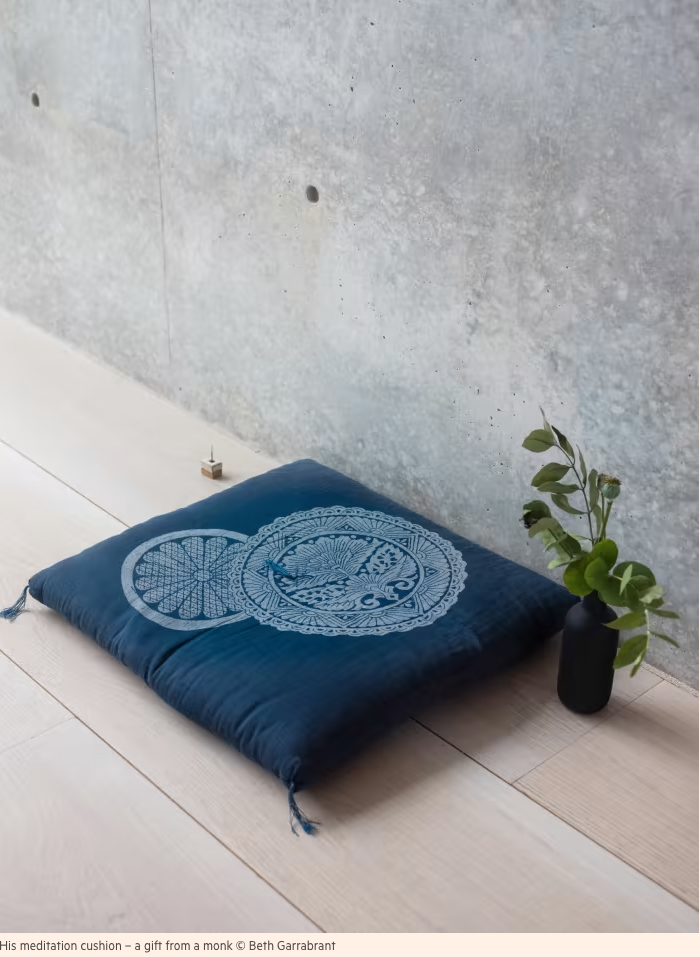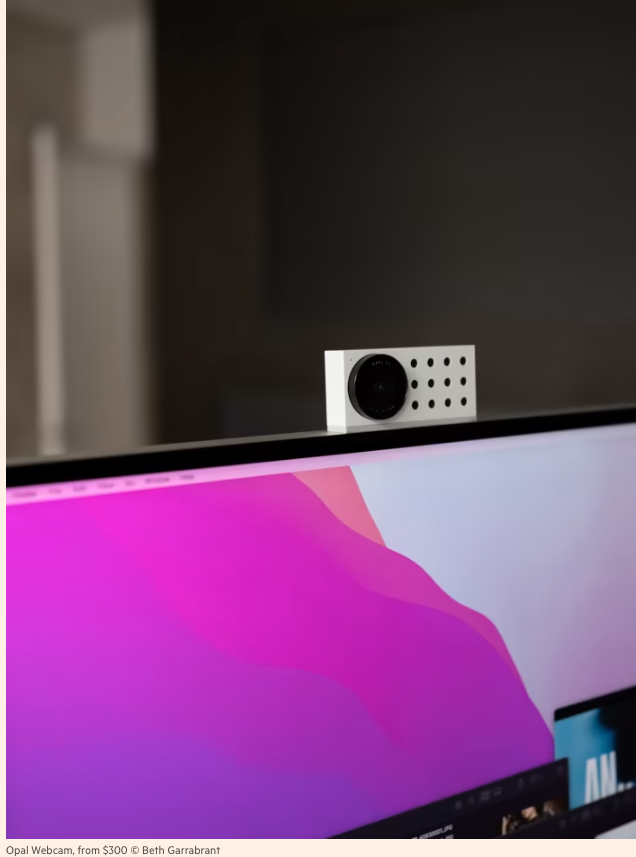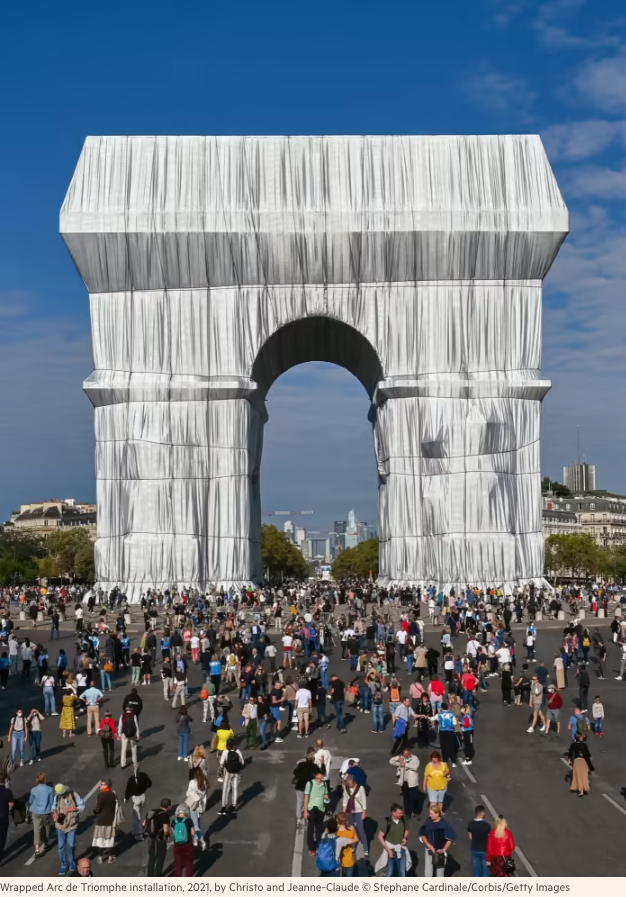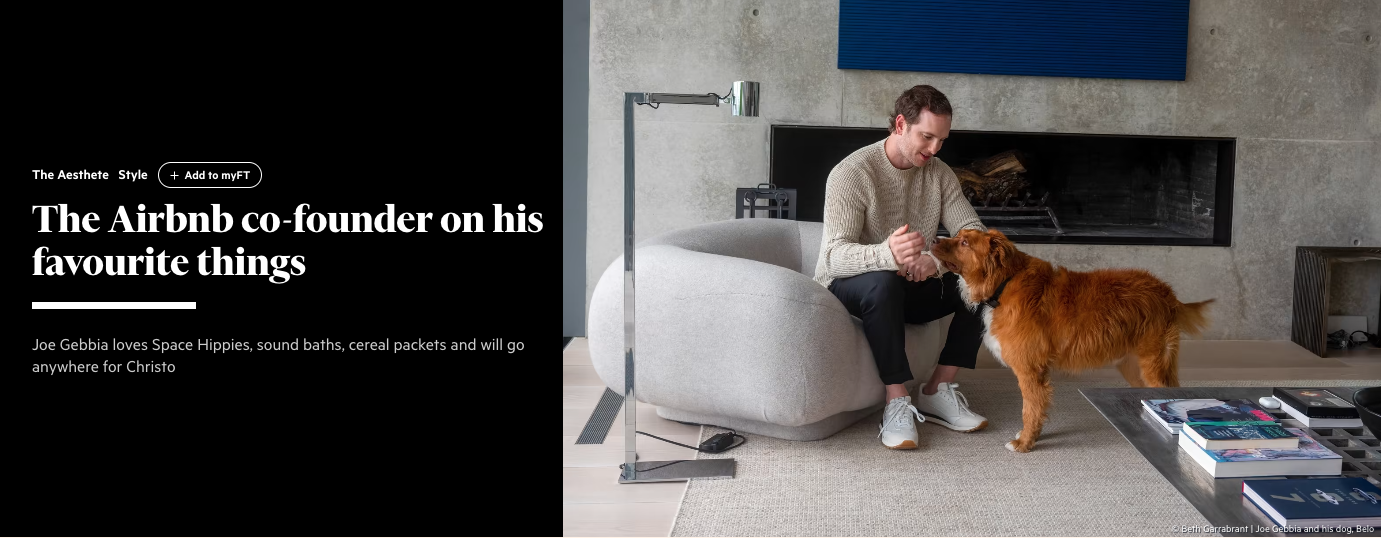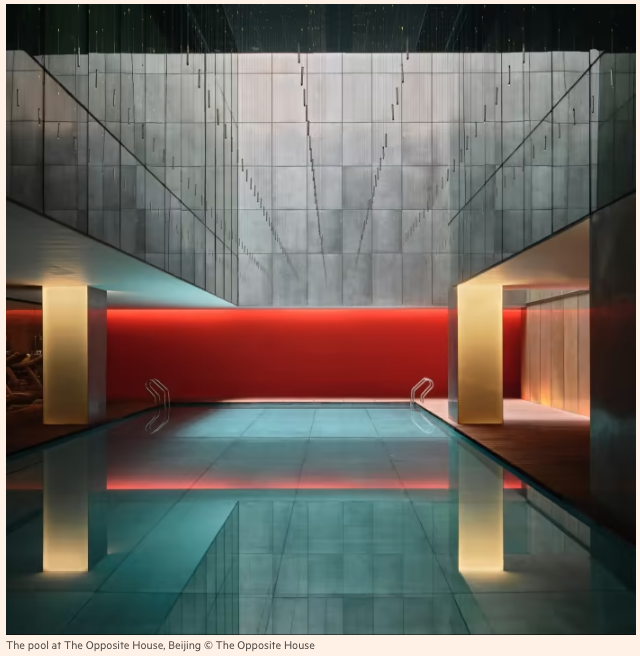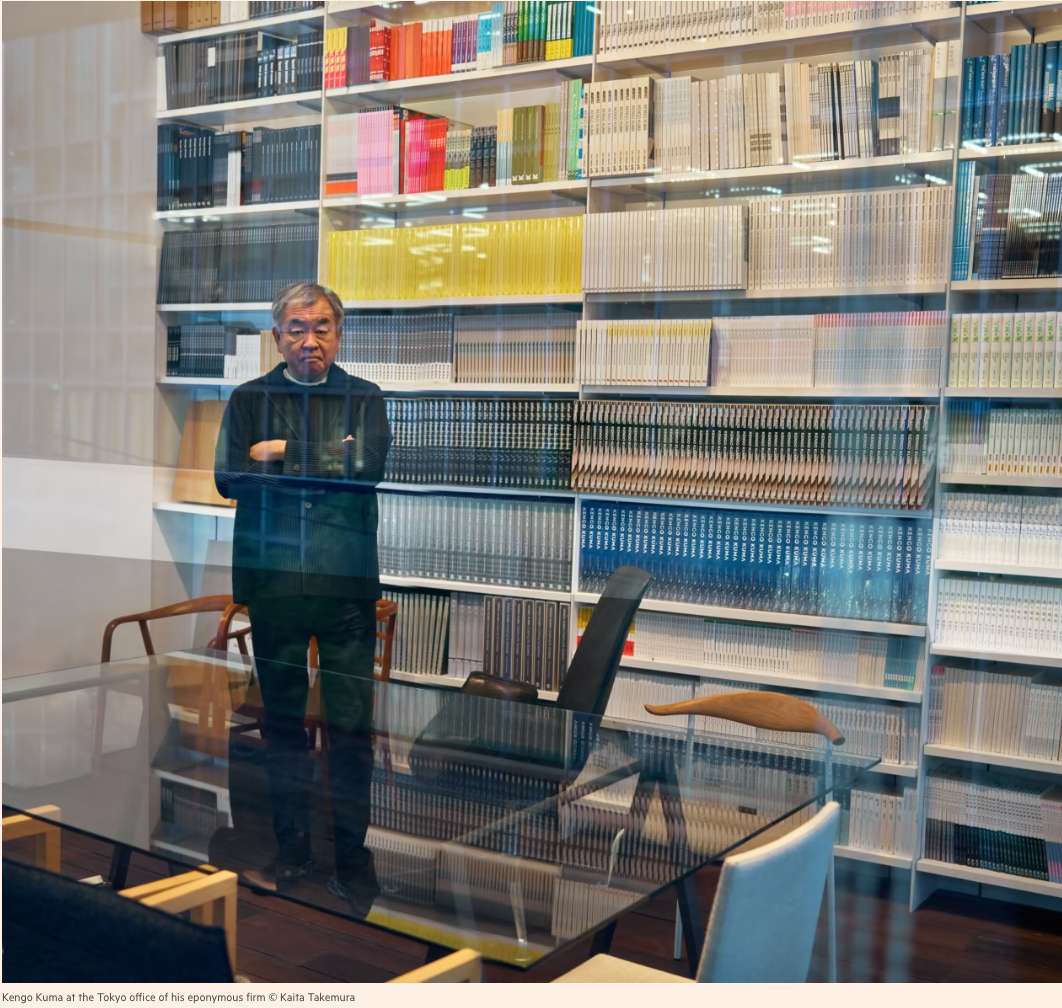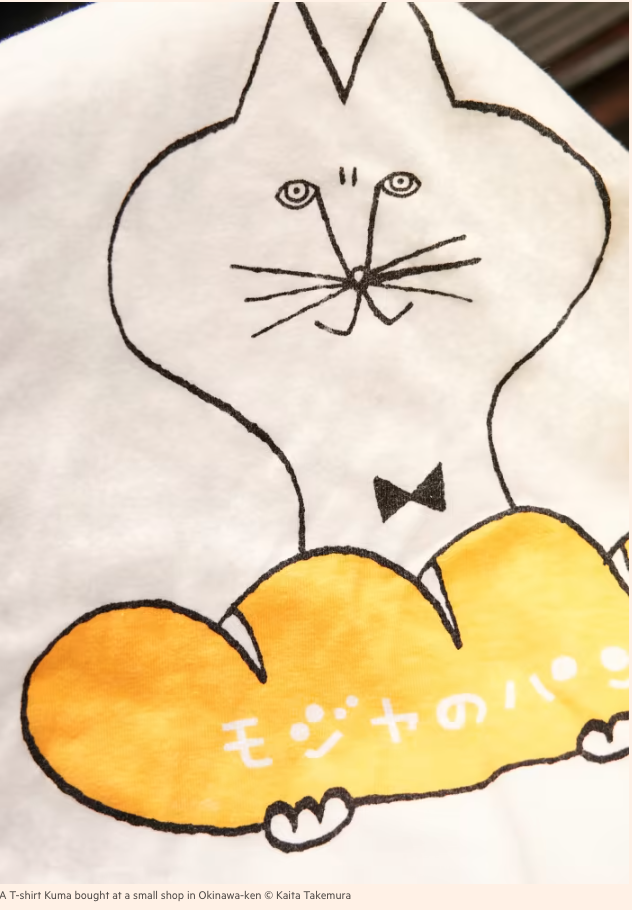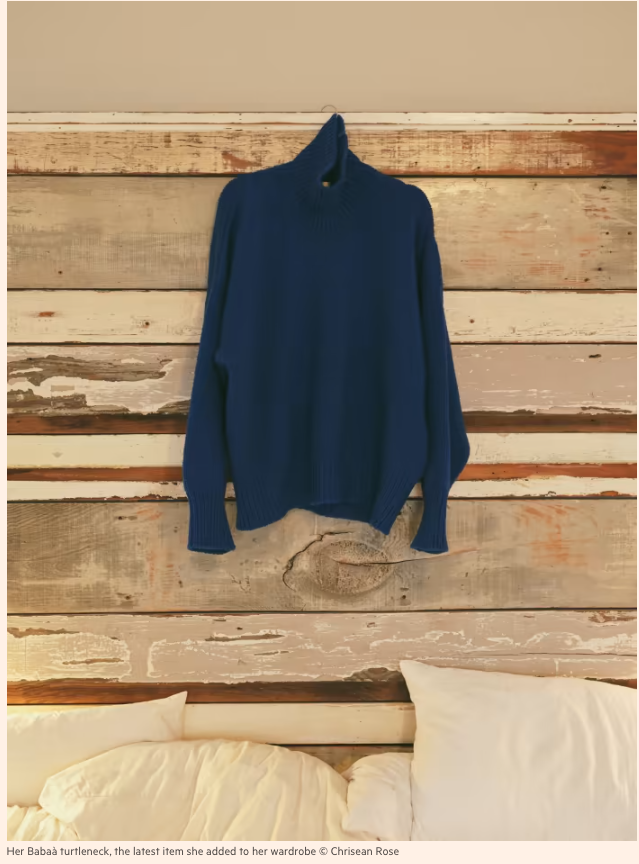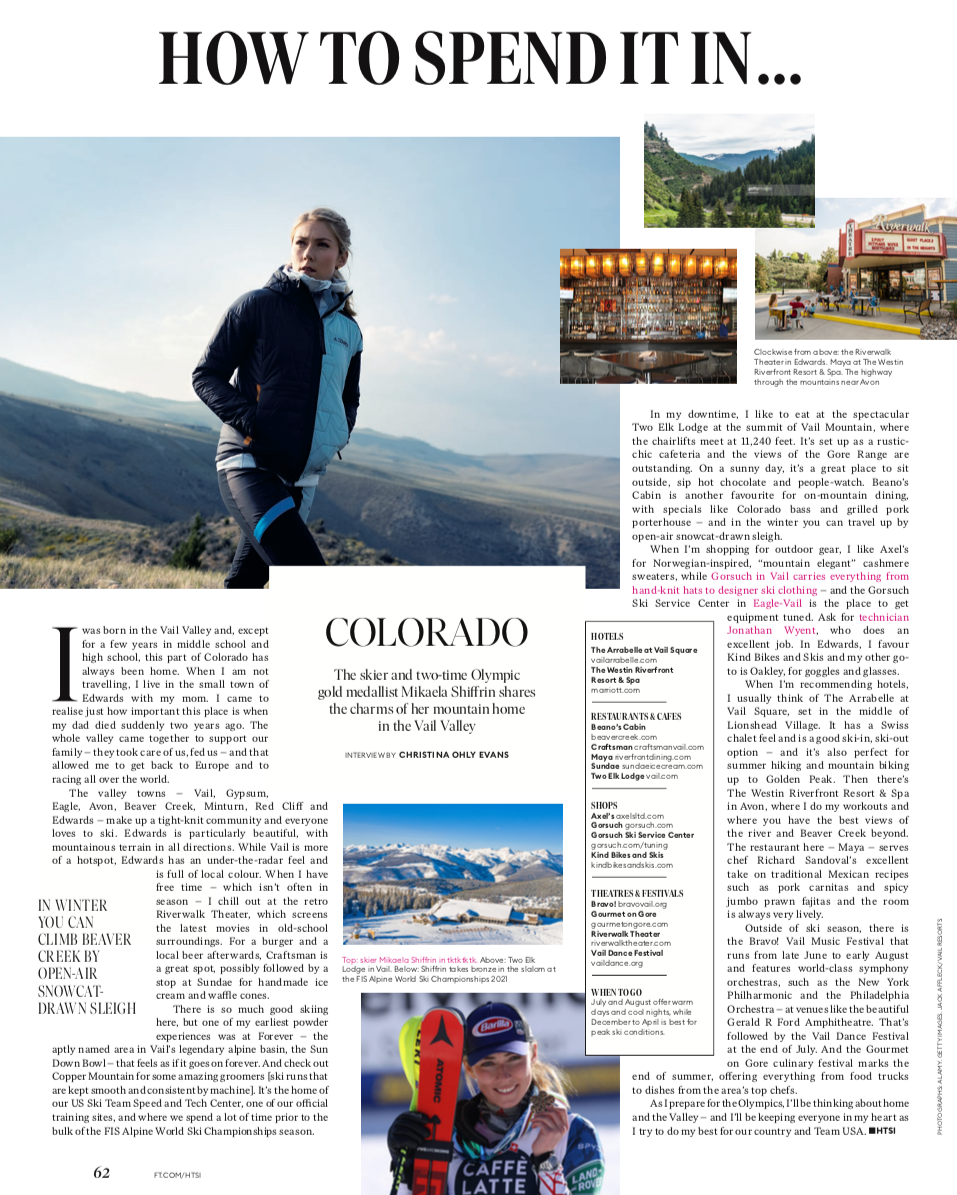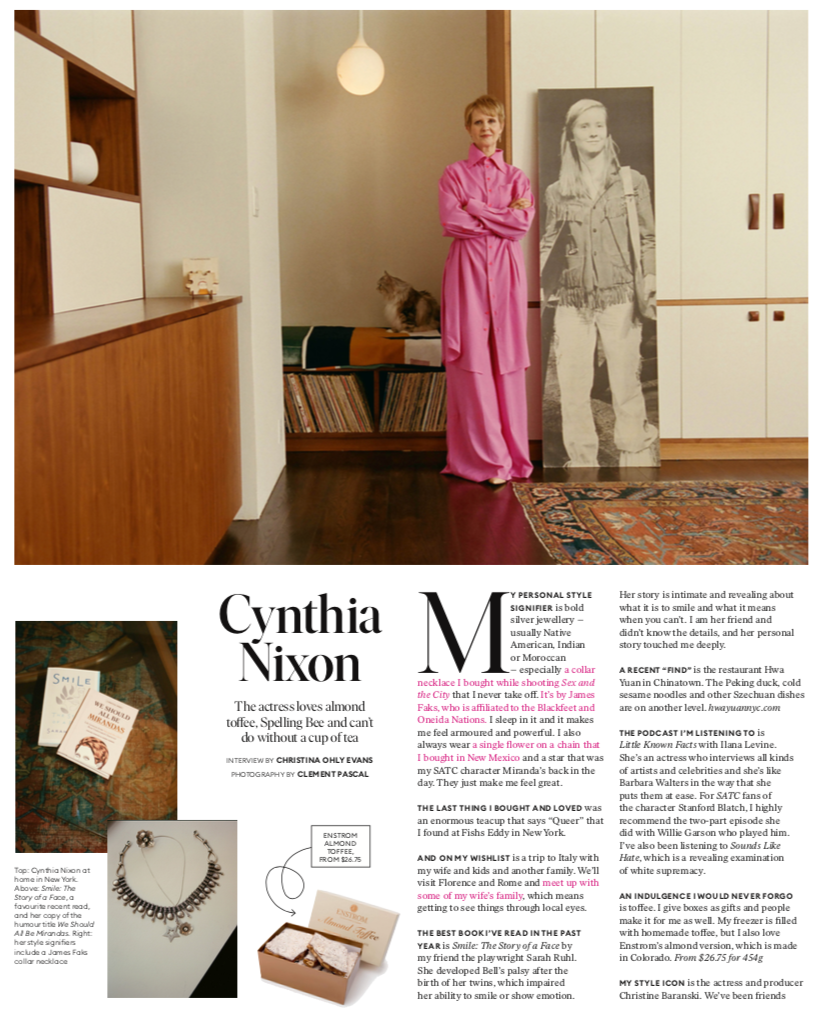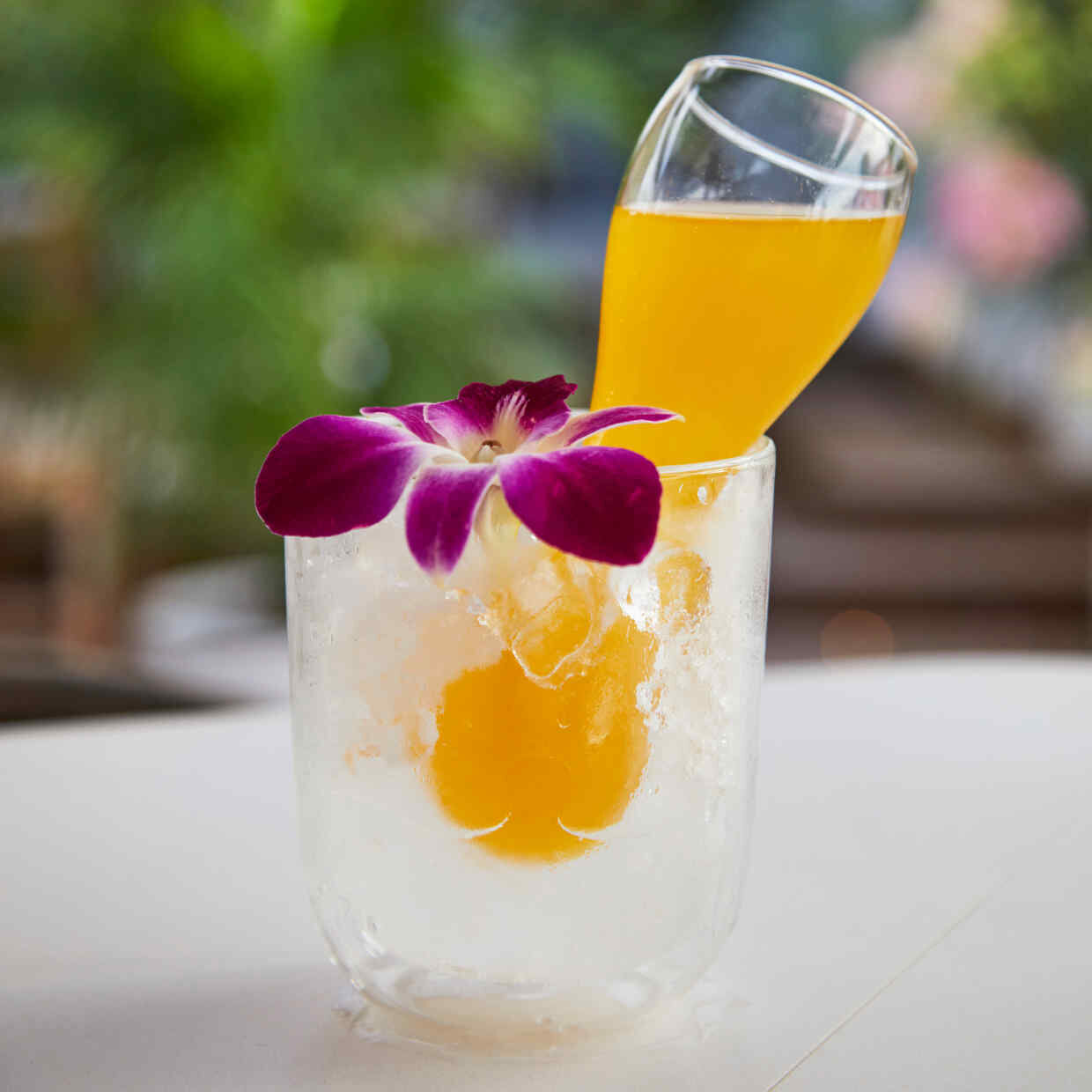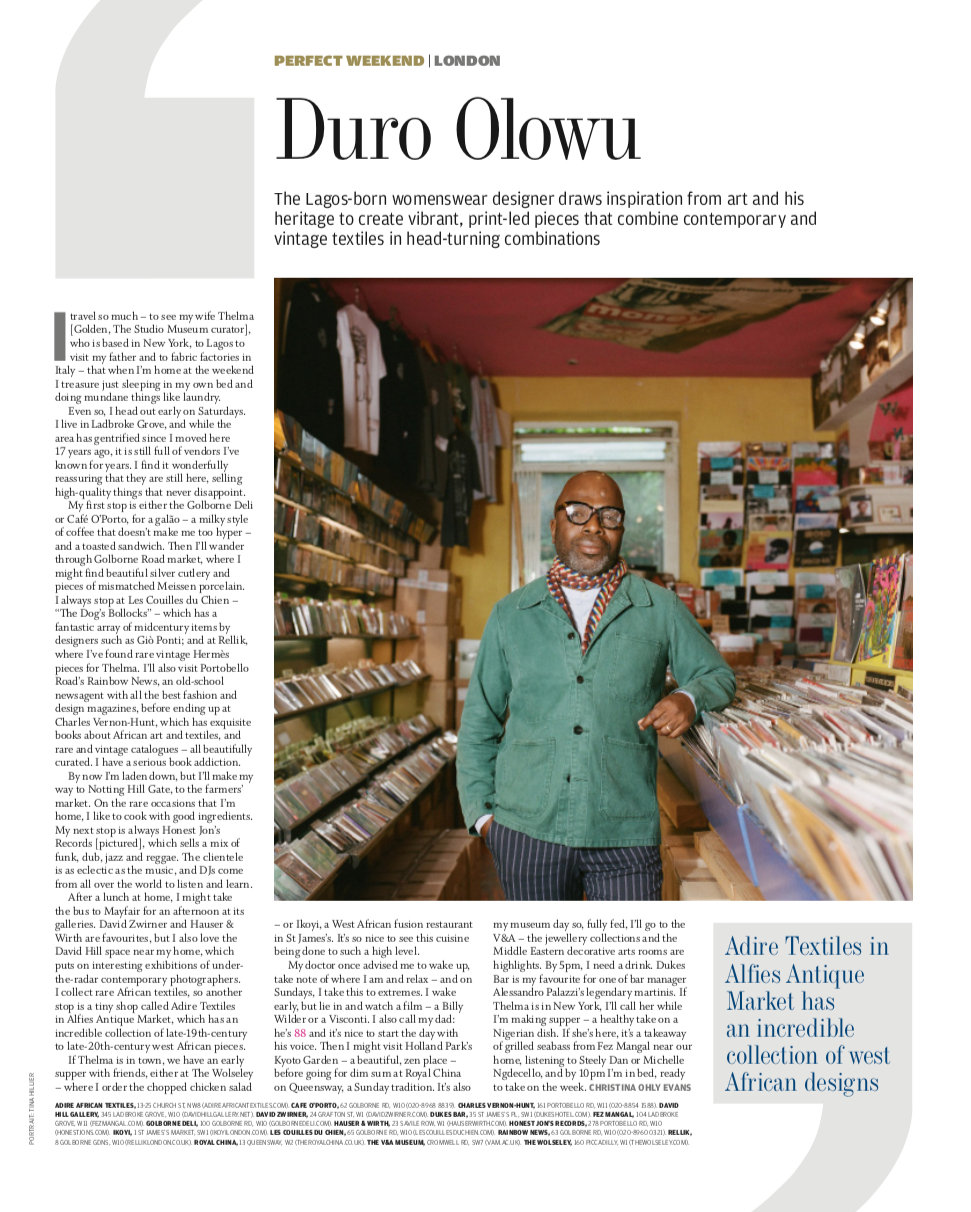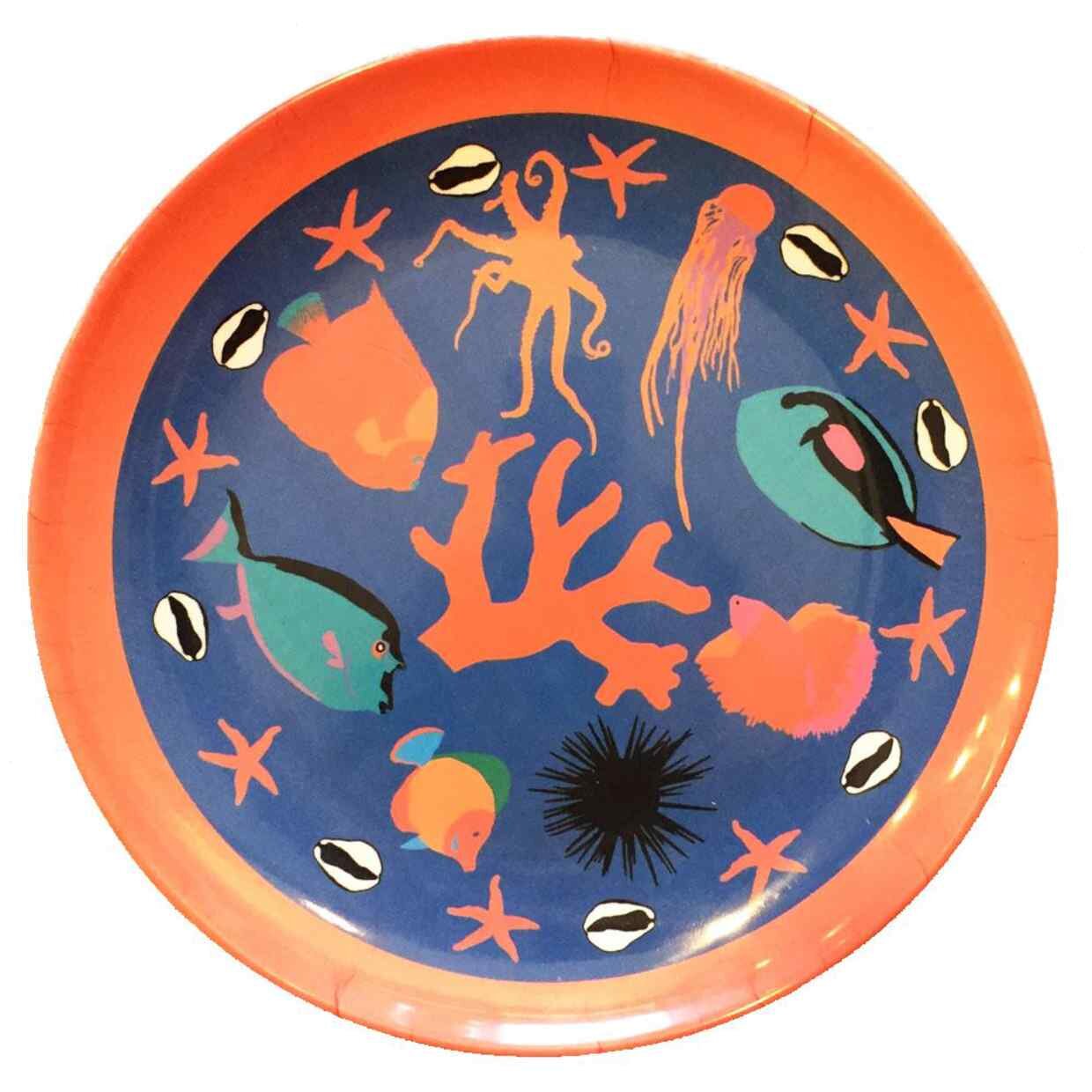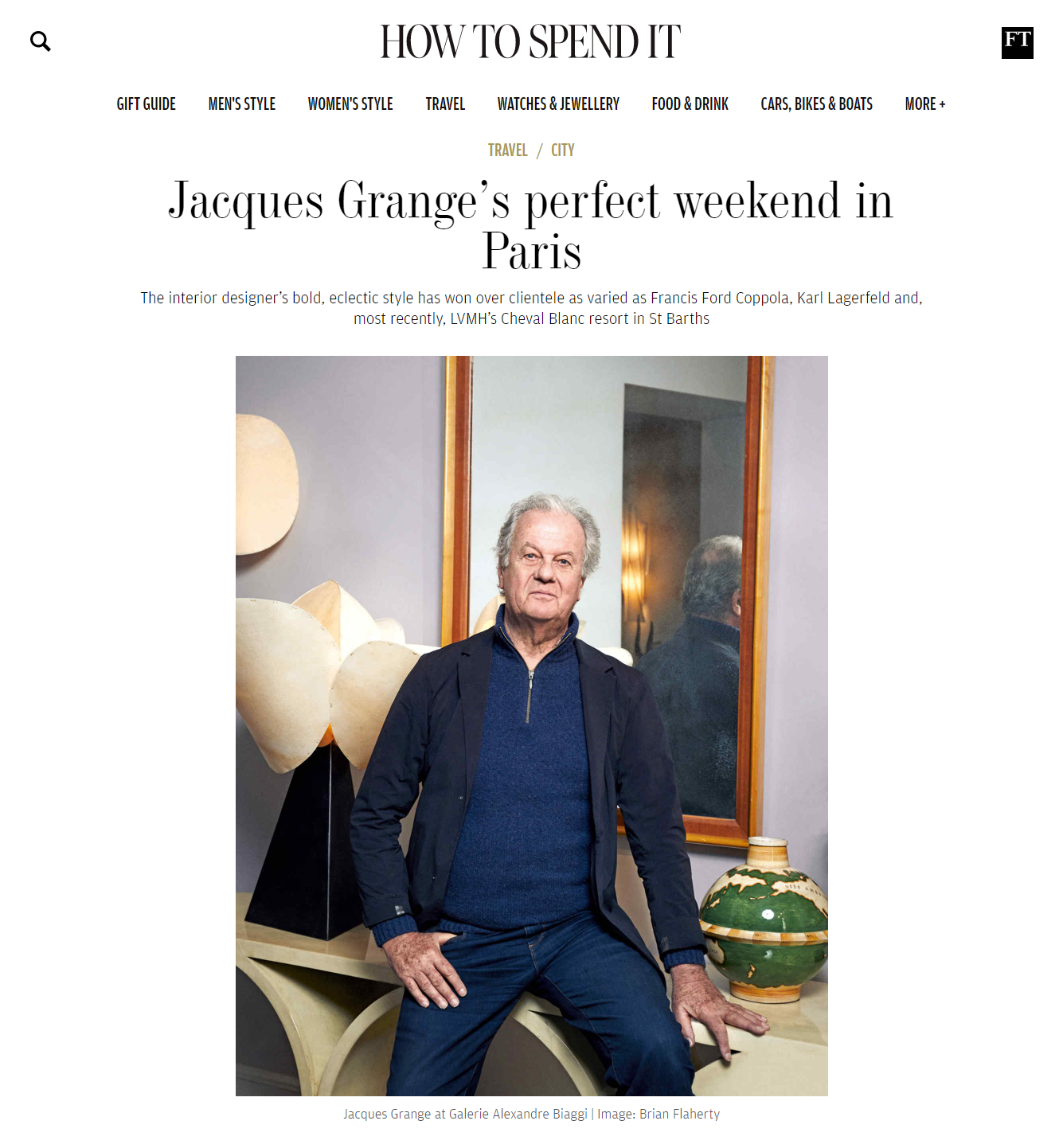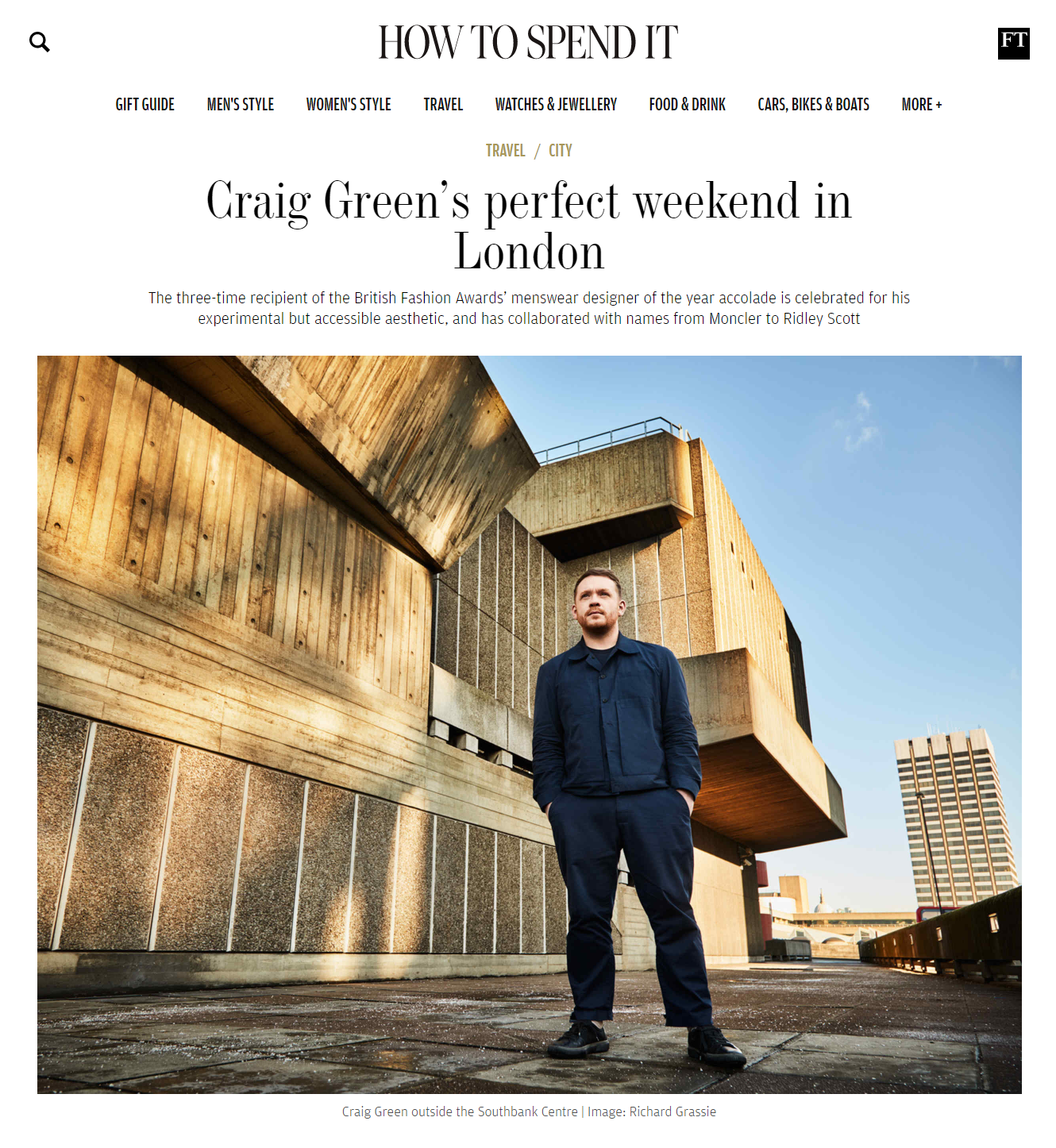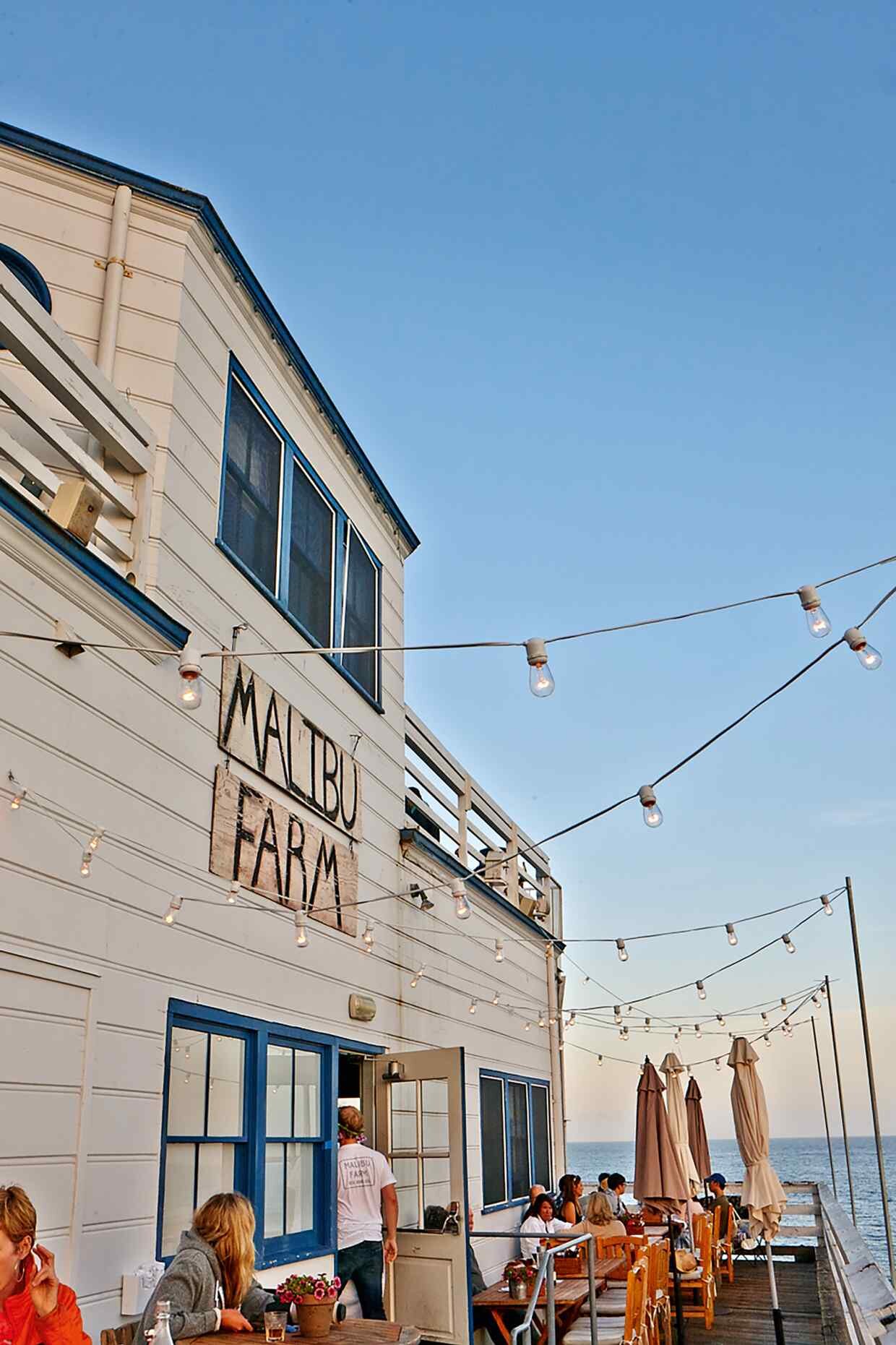Maria Sole Ferragamo’s secret guide to Sardinia
Maria Sole Ferragamo’s secret guide to Sardinia
The jewellery designer recommends her favourite places to eat, shop and stay
The jewellery designer recommends her favourite places to eat, shop and stay
I’ve been going to Sardinia every summer since I was nine months old to visit my maternal grandparents in Cannigione in the northern part of the island. When I was about 10, my father decided to buy a shipyard, Nautor’s Swan, which has held regattas here ever since. Now I live in Milan and find Sardinia to be the perfect weekend getaway.
I have sailed all around the island – it’s a wonderful way to see the beaches and remote villages. I’ve also explored the hinterlands by motorbike, once travelling 270km down the east coast – and then back up the west coast. At one point, I was surprised to find myself in a mountain chalet in an area called Gennargentu, which has the highest peaks on the island. It’s what makes Sardinia so special. You can find mountains, forests, beaches and lakes that are unique to this place. I especially love the cork trees. They are sustainable because the cork is shaved and then grows back; it’s a material I’m fascinated by. My grandfather used cork for his original wedge shoes and I’d like to incorporate it into my jewellery designs.
Costa Smeralda is probably the most well-known part of Sardinia – I’m particularly familiar with Porto Cervo. There are, of course, beautiful beaches, restaurants and clubs here, but there are also quiet spots with spectacular sunsets. In September, Sardinia’s rocks appear even more pink and orange than usual. The harbour itself has been updated and now includes the New Port as well as the original Old Port, with a ferry running between the two in summer. The new side – the Promenade du Port – is the place to find wonderful shops including one of Franco and Giacomo Loro Piana’s Sease stores, for sailing gear, and Milan gallerist Rossana Orlandi’s Sardinia space. On the old side you’ll find the Yacht Club as well as a store run by Italian sailing brand Slam. For fruit and cheese the best market is probably the Thursday one in San Pantaleo, about 20 minutes away.
From Porto San Paolo you can see the majestic Tavolara Island, which is only accessible by boat. There’s a wonderful restaurant called Ristorante da Tonino Re di Tavolara that you have to book well in advance, and which serves unbelievably fresh crudo. Another lovely port is Porto Rafael, a small village just 30km away from Porto Cervo, and also easily accessed by boat. The busy piazza is full of cafés and it’s the perfect place for an aperitivo.
The south of the island is my favourite area. I like to stay at Faro Capo-Spartivento, in Chia, originally built as a lighthouse in the 1850s. It’s respectful of the landscape, and its water is heated by solar panels. There are a few suites in the lighthouse as well as on the surrounding property, and it feels very intimate. Then there’s the village of Villasimius, just an hour from Cagliari, known for its beaches and archaeological treasures. I always recommend a stay at the Falkensteiner Resort Capo Boi, set on a white-sand beach in the marine reserve of Capo Carbonara. La Vela restaurant with its views over the marina at sunset is a favourite of mine.
The terrace at Capo Spartivento
Sardinian cuisine is full of variety. In the town of Carloforte, on San Pietro island, they are famous for their tuna and the freshest bottarga. Everyone should try a Sardinian seada, a hot pastry made with cheese and honey. And I highly recommend trying the food at an agriturismo – these places have fixed menus and you start with cheeses, meats and pane carasau – a thin, crispy flatbread that’s specific to Sardinia – followed by Gallura soup (a sort of bread lasagne). You will roll out the door, but it is worth going at least once.
April is a wonderful time to visit, as is November. And although peak season is of course hectic, even in busy August, you can still find places that are tranquil. The Rolex Swan Cup usually takes place every two years, and is happening again this September. It is magnificent to see 100 Nautor’s Swan sailboats all in one place, racing around the Costa Smeralda. At this time of year, the crowds thin and the days are a bit shorter, and Sardinia’s rocks appear even more pink and orange than usual.
Designer Robin Standefer’s insider guide to Montauk
Designer Robin Standefer’s insider guide to Montauk
The co-founder of design studio Roman and Williams on why it’s worth travelling to the tip of Long Island
The co-founder of design studio Roman and Williams on why it’s worth travelling to the tip of Long Island
Montauk has always been a place for artists and thinkers: Edward Albee, Stanford White, Andy Warhol and Mick Jagger all spent time here, each drawn to the dramatic landscape of “The End”, as the eastern tip of Long Island is known. I first came here as a teen, and when my husband and business partner Stephen [Alesch] and I needed a retreat from the city, it seemed like the perfect place. We have now called the area home for over 20 years and we love everything about it: the ocean, the farms, the fishing boats and the history. This is our spiritual home – the place that centres us – and it’s where we’ve developed ideas for everything from the British Galleries at The Met to homes for Gwyneth Paltrow and hotels for André Balazs. It’s also the place that has inspired our lighting and furniture lines and even our menus at the restaurant at our New York store RW Guild, because the produce and seafood here are so phenomenal.
Montauk offers two entirely different experiences just a few miles apart. There is the calm Long Island Sound on one side, where Sunset Beach and Gin Beach offer gentle swimming and walks, and the noisy Atlantic Ocean on the other, with its dramatic cliffs and surf breaks. People love to talk about the traffic getting to the Hamptons and beyond, so at peak times the train is a great option, as is the Hampton Jitney [a motorcoach company]. I love watching the landscape fade from dense to wild as you leave Amagansett behind and enter Montauk. There are no manicured lawns out
There are plenty of places to stay, from the hip and sexy Crow’s Nest by Sean McPherson of The Bowery Hotel, to the minimalist Marram hotel, which sits right on the beach and has yoga and biking. And Gurney’s is an old school institution that has the excellent Seawater Spa, and feels like a total escape. I like to get a morning coffee at Left Hand. For fish, Gosman’s Gourmet Fish Market is my go-to, and I’ll get up at 6am to buy tuna that’s just come off the boat. There’s also the seafood market Multi Aquaculture Systems, aka the Fish Farm. The place is scattered with buoys and nets and you can pick up incredible takeaway – they’ve got it all, especially local colour.
There is much less of a party scene out here than in the Hamptons. Duryea’s Lobster Deck – a seafood restaurant on the dock overlooking Fort Pond Bay – has a south of France vibe, and is perfect for a glass of rosé at sunset. Alimentari Beach on Montauk Highway has great coffee and pizzas that you can eat outside in the little plaza. To live like a local you need to surf and, if you’re lucky, you’ll get to surf with the harbour seals. Stop at Air + Speed Surf Shop to rent a board – they give lessons, too – or just to buy a cool T-shirt.
There are also great bike tracks and walks around the coast – much of it is state parks, like Shadmoor Park – as well as ferry rides to Block Island for whale watching. For the best views of the coast, visit the Montauk Point Lighthouse – the oldest in New York state. The 19th-century Pollock-Krasner House – once the home and studio of artists Jackson Pollock and Lee Krasner – is wonderful, too. The farmhouse is just as they left it in 1984, right down to the drips from Pollock’s paintings on the floors. A bit further on, in Water Mill, is the Parrish Art Museum. It was designed by Herzog and de Meuron and you can see works by artists such as Sol Lewitt and April Gornik, who have ties to the area.
The summer is high season, of course, and while places like Ditch Plains can be crowded, you can be blissfully alone and left just to collect rocks in spots like Camp Hero State Park – even in August. Autumn is spectacular. You can still surf and hike, the air is crisp and cool, and there is fantastic apple-picking. We always host a harvest dinner in late October. Winter feels very Scandinavian – there is lots of fog, and sometimes it snows. Our Reed candlesticks were inspired by the dried stems you see in Montauk in this bleak but beautiful season. Montauk is so environmentally protected that I don’t worry too much about it all changing, or the wild beauty of the gardens or the shape of the coastline deteriorating. I do, however, want it to remain a place for explorers, and I also want to see it stay balanced, because that’s what makes Montauk so cool.
Joe Gebbia - The Airbnb co-founder on his favourite things
The Airbnb co-founder on his favourite things
Joe Gebbia loves Space Hippies, sound baths, cereal packets and will go anywhere for Christo
Joe Gebbia loves Space Hippies, sound baths, cereal packets and will go anywhere for Christo
My personal style signifier is a pair of Nike Space Hippies – a modern marvel of sneaker design. They’re made of recycled materials – plastic bottles, T-shirts and post-industrial scraps from the factory – and I like that they’re environmentally low-impact, incredibly comfortable and distinctive. I have them in high-top and low-top versions, in grey and orange. Along with my titanium Ressence watch, they are my everyday staples.
The last thing I bought and loved was a set of Syng triphonic speakers. I love reaching the end of the day, when I can blast out some music. They are spread equidistantly through the room in order to create a sound bath – the sound quality is a revelation.
I’ve recently rediscovered my love of live sports. Since moving to Austin, I’ve become a partner in the San Antonio Spurs, and getting to go to basketball games again – sitting courtside, feeling that energy, watching people convene – has been wonderful.
The best souvenir I’ve brought home is a meditation cushion from a Buddhist monk in Oita, Japan. He’s an Airbnb host and he gave it to me when I stayed in his temple. I got to live the life of a monk on that trip – meditating at 5am, cooking meals in his kitchen, tagging along to the village where he performed rituals in people’s homes. I still use it often. My style icon is Haider Ackermann. His designs look like no one else’s, and his work is a reflection of him – informally formal.
The best gift I’ve given recently was cereal boxes, which I designed for our early investors and each member of our executive team, to commemorate our IPO. Each one had that person’s likeness on it. I made 40 or so boxes, so it was a time-intensive project. It was a homage to our Obama O’s breakfast cereal of 2008, which we sold to keep Airbnb afloat at that time. The last music I downloaded was the album Battle Lines by the Canadian electronic duo Bob Moses. It’s a mix of wistful lyrics, pop beats and synths.
The objects I would never part with are my sketchbooks. I have them custom-made in three sizes and with weighty paper so that the ink doesn’t bleed through the pages. I sketch first concepts – for example, for Neighborhood, a furniture line I did with Bernhardt – and I also draw people, so that I have a written and visual record of meetings.
I have a collection of midcentury modern chairs. Many of the pieces are by Charles and Ray Eames and also by the Dutch designer Gerrit Rietveld, who broke the mould of what furniture was supposed to look like. I have Rietveld’s Red and Blue chair, and also his Zig Zag and Crate chairs. And I have an Eames daybed-like one that they made for the director Billy Wilder, who used it for napping on movie sets.
In my fridge you’ll always find maple syrup and butter for making pancakes at the weekend. I have a wide variety of syrups – all the grades, all the light and dark versions – and like to make pancakes for whoever is staying with us. I also have Hello Pure dog food for my puppy, Belo.
The thing I couldn’t do without is my Opal webcam. It’s beautiful and of the highest quality – they have somehow packaged DSLR-level quality into a camera that fits in your pocket.
An indulgence I would never forgo is travelling to see a Christo and Jeanne-Claude installation anywhere in the world. I was recently in Paris for the Arc de Triomphe installation, and at Lake Iseo for The Floating Piers before that, and in New York to see The Gates in Central Park in 2005. I find it the most profound public art. There is one more left to go – The Mastaba in Abu Dhabi – which will be bigger than the Great Pyramid, and you can bet I will be there.
The carry-on essentials I’m never without include my Porter-Yoshida & Co briefcase, a black nylon model with plenty of compartments. It also holds some important things such as my Manta Sleep eye mask, which has an adjustable Velcro strap so that no light slips in and is as soft as butter. I’m also never without my 16in MacBook Pro – it’s got a big screen and is super-fast – and my Leica M10, so I can bring back some memories.
The last item of clothing I added to my wardrobe was a Dolce & Gabbana three-piece suit in polka-dot silk jacquard that’s killer. I wore it for this year’s Met Gala.
The one artist whose work I would collect if I could is Willem de Kooning. I’m reading his biography now and he had an incredible life; he grew up impoverished, made his way to America, helped to define the abstract expressionist art movement and lived the dream. I would like any painting from his Woman series.
My favourite building is the Rothko Chapel in Houston, Texas. It’s an octagon that contains 14 of Mark Rothko’s monumental murals.
My wellbeing gurus are a physician – Peter Attia – who helps me figure out what I should be eating and is focused on longevity. I also love a good myofascial massage where they dig really deep into your muscles and find all of the problem spots and work them out. And I’ve been searching for a new jujitsu trainer.
My favourite website is – sticking close to home – airbnb.org, the non-profit side of our business. We partner with people to house refugees and displaced citizens in times of crisis. Right now, Ukraine is a huge focus and we’ve promised to host 100,000 people. The plug here – for anyone reading this – is if you have an extra room, please sign up. We are focused on rooms in Europe – Poland, Slovakia, Hungary, Germany, Denmark, Sweden – but anyone can help. As far as apps go, I use the Oura app to track my sleep. I average six and a half hours per night, and no matter what I do, I can’t seem to change it.
In another life, I would have been a film director. I am starting to explore filmmaking by producing a documentary about the IOC Refugee Olympic team that participated in last year’s Tokyo games. This all-refugee team comprised 29 athletes, originating from 11 countries, and residing in 13 host nations. Their resilience is inspiring.
My favourite room in my house is my gym. I start my day here and it sets the tone; working out is my form of meditation and I am rarely distracted when I am doing it. It used to be a garage, so I just added a skylight and I open the door wide for natural light. It’s equipped with the basics: a bench, cables, free weights, kettlebells, a leg press and an elliptical machine. My goal is three hours of cardio a week at a target heart rate of 125bpm, plus four days of strength training.
The place that means a lot to me is the Eames Ranch in Petaluma, California. Spread over 27 rolling acres in Sonoma County, it’s surrounded by farmland with sheep and a llama. The original house and barn were designed by architect William Turnbull, so it’s an iconic place – and it’s now the site of a non-profit I helped start called the Eames Institute of Infinite Curiosity. It contains many of the original Charles and Ray Eames sketches, prototypes, films, books and textiles.
The best bit of advice I ever received was via CNN, when I was in high school. I was watching an interview with Warren Buffett on investing and I was expecting a stock pick, but instead he said to “invest in yourself”. As a kid, I’d never previously considered this concept, but it’s an important one.
The trip that I’m looking forward to next is to the village of Mezzojuso, in Sicily. My ancestors came from this small, hillside village in the country and I visited once before, as a surprise holiday for my whole family. I worked with the mayor and council members to find the old ledgers and birth certificates and we traced our family back to the 1700s. I organised a party for the village, and we were granted honorary citizenship – it was an exceptional moment, and my dad was in tears, being in the place where his grandfather had emigrated from in 1900.
The best book I’ve read in the past year is The Truth: An Uncomfortable Book About Relationships by Neil Strauss. It’s a book of relationship advice and it’s insightful, funny and chock-full of observations on commitment, love and family. We did a talk together at South By Southwest and he recommended it to me. It’s a truly hilarious book.
The podcast I’m listening to is Hidden Brain by NPR. It’s all about psychology and helping us to understand why we do what we do. My favourite episode is one about the placebo effect; it’s fascinating on the power of the mind.
And the best gift I’ve received is a speech that was given by my co-founder and friend, Brian Chesky, for my 40th birthday. Somehow, he managed to capture 22 years of our friendship in a funny, heartfelt, deeply touching toast – in front of 180 people, no less – that I’ll never forget. The speech now hangs framed on the wall of my office. Brian is as talented a writer as he is a businessman.
Kengo Kuma: ‘I am not attached to objects at all’
Kengo Kuma: ‘I am not attached to objects at all’
But the Tokyo-based architect still loves tenuguis and his cat T-shirt
But the Tokyo-based architect still loves tenuguis and his cat T-shirt
My personal style signifiers are minimalist, comfortable clothing – black jackets, sometimes by Issey Miyake, and always T-shirts. My clothes are like my own designs: spare and simple.
The last thing I bought and loved was a Danish chair for my furniture collection. The design is human and intimate. I have Mies van der Rohe and Hans Wegner chairs; architects often like uniformity but I like to experiment with different styles.
The place that means a lot to me is The Opposite House in Beijing – although I am slightly biased as it’s my own design. It’s a hotel, but the use of natural materials such as wood and stone makes it comfortable and warm. It is an oasis. Everything is minimal – a stainless-steel pool, wooden water basins – so it feels serene and uncluttered.
The design that has most inspired my work is a set of black ceramic tiles that were given to me in China. These influenced my design for the China Academy of Art in Hangzhou, specifically the grey roof. I love the beauty of Chinese ceramics, and materials that are of a place.
The best book I’ve read in the past year is First Person Singular by my good friend Haruki Murakami. His novels have a sort of tunnel structure and I apply this same design philosophy to my buildings. We inspire each other.
My style icons are farmers. I like workwear and the simplicity of this local vernacular. My grandfather taught me how to grow vegetables and was a mentor to me. Another icon is Sen no Rikyu – a 16th-century Japanese tea master who raised the ritual to an art form.
The best gift I’ve given recently was a sketch, to a client, made on tenugui “kerchief” – a gift towel used to wrap presents. I like to sketch on tenuguis. They are applied with a special dyeing process and have a rough texture, but are nonetheless elegant.
And the best gift I’ve received is a huge load of vegetables from the mayor of the city of Sakai-shi in the Osaka prefecture. I am designing some small buildings for the community there, and as a thank you he gave me all kinds of fresh produce – aubergines, cucumbers, ginger – which were all irregularly shaped, not shiny like supermarket produce. They were a different kind of delicious.
The last music I downloaded was by Ryuichi Sakamoto, who worked on The Last Emperor. We are longtime friends and I have been influenced by his music. It remains very contemporary.
In my fridge you’ll always find Japanese sake, especially old sake from the Masuizumi label. They make two-year-old and five-year-old sakes that are full of unique flavour. You’ll also find genmai brown rice which has a rich, nutty flavour. My style icons are farmers. I like workwear and the simplicity of this local vernacular
The works of art that changed everything for me were Japanese gardens. These are, to me, more spectacular than any painting. Muso Kokushi was a 14th-century designer who has influenced my own work so much – his use of moss and stone was wild and stunningly beautiful. He is considered a “national Zen teacher”.
I’ve recently rediscovered funazushi, a type of fermented sushi that was popular before there was refrigeration. Some can’t eat it because of the smell, but I particularly like the crucian carp variety. You won’t find this in Tokyo, but rather in seaside prefectures such as Toyama-ken and Fukui-ken.
The one artist whose work I would collect if I could isn’t so much an artist as an art form: Chinese and Japanese calligraphy. These scrolls are impressive; I love the contrast of rice paper and ink.
The grooming staple I’m never without is Hatomugi rice soap. I have tried many other kinds but this is the best. It is made with seeds and is very cleansing.
An indulgence I would never forgo is… Nothing. My tastes are simple.
An object I would never part with is… Nothing. I am not attached to objects at all.
My favourite room in my house is my terrace in Tokyo. I love outdoor spaces and I have a collection here of all kinds of plants. Every morning small birds come to feed and it’s a serene setting. In another life, I would have been a veterinarian. I adore animals, particularly cats.
The best bit of advice I’ve ever received was from a university professor who said: “Don’t refuse anything, accept it all.” He encouraged me to be open to all new things – places, people, foods. We travelled to the Sahara together and it was so eye-opening. A university professor told me: “Don’t refuse anything, accept it all”
The best souvenir I’ve brought home is an inexpensive, classic Chinese shelf that I purchased in a nondescript shop in Beijing. It’s now in my living room and holds all of my souvenirs. I travel the world – we have projects in more than 30 countries – and so my taste in souvenirs is eclectic.
I have a collection of rice papers from all over Asia. I have many different textures, all in different shades of white, and each relates to a specific place. I use them for making pictures with pen and ink.
The last item of clothing I added to my wardrobe was a T-shirt with an image of a cat that I got in a small shop in Okinawa-ken. I love cats and quirky things that aren’t mass-produced, and this T-shirt is fun and comfortable.
The things I couldn’t do without are pencils. I sketch whenever an idea strikes so I carry pencils with me everywhere, in all of my pockets. I don’t much care what brand, just so long as I have a piece of paper and a pencil on hand…
The buildings that changed everything for me are by Frank Lloyd Wright. He came to Japan and found the essence of our culture in a way that we couldn’t. This translated to his buildings, in particular Fallingwater, the Pennsylvanian house that he designed in the 1930s. It has literally made me weep.
Lauren Ridloff, the first deaf Marvel superhero, talks personal taste
Lauren Ridloff, the first deaf Marvel superhero, talks personal taste
The actress loves her Makkari figurines, the late Anthony Bourdain – and her kettlebells
The actress loves her Makkari figurines, the late Anthony Bourdain – and her kettlebells
My personal style signifier is my hair, usually worn natural and loose, though I have braids right now. My hair is the first thing that people notice about me and I’m proud of my curls. I also like the ’70s look and tend to wear high-waisted, wide-legged Jesse Kamm pants. I’m a fan of supporting small, women-owned businesses. jessekamm.world
The last thing I bought and loved was a complete set of TRX kettlebells. My personal trainer, Anne Reuss, does strengthening work with me using these weights. They make me feel athletic, strong and graceful. Anne Reuss, hearanneout.com
I have a collection of Makkari figurines. Makkari is the superhero I played in Marvel’s Eternals and being deaf is one of her powers. I’m just so proud of this character. My collection has a Funko Pop version, one that I got from a McDonald’s Happy Meal, a Hasbro one with moveable arms and legs, and a Lego figurine. If I am feeling blocked or upset, a run is always the answer
The place that means a lot to me is a small beach cottage in the Hamptons that has been in my husband’s family for years. It sits on a quiet bay where we go clamming, and my two boys love this place more than anywhere on earth.
The best book I’ve read in the past year is Kitchen Confidential by the late Anthony Bourdain. I loved his CNN series, Parts Unknown, and his writing is so raw and funny. Just as important was a book called Being Heumann: An Unrepentant Memoir of a Disability Rights Activist by Judith Heumann. It’s the fascinating story of Heumann’s fight for basic human rights such as an education and the right to work.
The best gift I’ve given recently is packing cubes for my husband. My publicist clued me into them and they make travelling so much easier. Now he can separate his garments – workout clothes, tops, sweaters – and put the cubes straight into a hotel drawer instead of unpacking.
My favourite apps include Cardzilla and Philips Hue. Cardzilla is a simple texting app that allows me to converse with people who don’t sign. It’s so easy to use with my castmates or in restaurants. I also love the Hue lighting app that allows you to change colours throughout the house – from room to room and by floor. My family is deaf, so we sometimes communicate with each other through the different bright colours we choose, and my kids love it.
In my fridge you’ll always find fresh herbs. They transform any dish and I like to add mint, coriander and basil to make herby soups and salads, dressing and smoothies.
The thing I couldn’t do without is my purple Moleskine journal. It has graph paper that allows me to make notes and to-do lists, and to log exercise in a very specific way. I carry it with me wherever I go with brightly coloured, fine-point Le Pen pens in orange, red and green that fit perfectly on the side. uchida.com
An indulgence I would never forgo is running. Whether I am feeling blocked or upset, a run is always the answer. Running gives me time to troubleshoot and to get in a zone. I often run past Domino Park, along the East River to Greenpoint, or over the Williamsburg Bridge and back across the Brooklyn Bridge. It allows me to feel fit and able and, mostly importantly, relaxed, so it’s a real priority for me. I’m currently shooting in Atlanta and I find that a run through Piedmont Park is a form of meditation.
An object I would never part with is an heirloom charm bracelet given to me by my mom and which once belonged to my grandmother. It has many different gold charms on it – when I was a teacher, my students could always hear me coming.
The last item of clothing I added to my wardrobe was a big, warm-blue turtleneck sweater by the sustainable Spanish brand Babaà. It has exaggerated long sleeves and is very Brooklyn-Mom chic. babaa.es
The grooming staple I’m never without is a Tangle Teezer detangling hairbrush. It fits in the palm of the hand, so it’s very manageable. I use it on my boys too.
The best bit of advice I ever received was from the Tony Award-winning director Kenny Leon. He said to “always come from a place of love” – meaning have the best intentions and all will work out right.
The best souvenir I’ve brought home is a teak stool that my husband and I bought on our honeymoon in Thailand. It’s a simple, portable stool that has grown with us and is now used by our boys in the kitchen. It’s a reminder of our beautiful trip to the Golden Triangle 16 years ago.
My style icon is Frida Kahlo. She embraced her disabilities – and her back brace and prosthetic leg – and made them statements by wearing bold, colourful skirts and big jewellery. And, of course, there were her big brows. She had a uniform and I relate to that too.
The best gift I’ve received is a Le Creuset teapot from my mother-in-law. This glazed stoneware pot has been a gateway to many more Le Creuset Dutch ovens and pans – in Caribbean blue, orange and cherry red. I love the bold pops of colour in my otherwise all-white kitchen.
The one artist whose work I would collect if I could is difficult to choose. I’d really like to collect the work of several artists to create a symphony: a calming Alice Neel painting for my bedroom; a Frida Kahlo portrait for the living room; and a Jean-Michel Basquiat painting in the dining room. Together they would really spark conversation.
My favourite room in my house is the kitchen in our brownstone in Williamsburg. It has great light and is the central hub for our family. We bought the house in 2009 during the financial collapse, and it was the best decision we ever made. Luckily, we had a great architect who reimagined this space from a closed galley to an open, sun-filled kitchen with enormous windows that open onto the back garden.
My favourite building is La Casa Azul in Mexico City. This was Frida Kahlo’s childhood home and the place where she learned to paint and spent much of the rest of her life. With its beautiful bright blue exterior, and a central courtyard and pond, it’s a magical place. museofridakahlo.org.mx
My beauty and grooming gurus are my close group of friends who advise me on everything from style to fitness to food. In addition, I rely on LA-based hairstylist Vernon François. He specialises in curly hair, and while I love my curls, I don’t like dealing with frizz. Vernon has taught me to fully embrace it. vernonfrancois.com
In another life, I would have been a ballet dancer. My older sister was a professional dancer and is a choreographer in Chicago – I would have loved to continue in the dance world.
Actor Matthew Broderick’s guide to Broadway
Matthew Broderick’s guide to Broadway
The New York native has lived in a six-block radius his whole life – and that’s just the way he likes it
The New York native has lived in a six-block radius his whole life – and that’s just the way he likes it
I was born in Manhattan, and first lived on Ninth Street at Fifth Avenue before moving a few blocks to Washington Square North. My wife [Sarah Jessica Parker] and I shared our first apartment in Soho, but we now live back in Greenwich Village where I started, so I basically haven’t gotten out of a six-block radius my whole life. I love it here: the buildings are low so you can see the sky and it’s a short walk to the Hudson River, which is now an extremely pleasant place to walk. Although the area has gentrified, it retains a sense of weirdness and quirk, and I like that I still see elderly people hauling their groceries from small local shops. The area has kept its history, the brownstones and tree-lined streets are the same, my friends are still here, and my kids go to the same school that I did.
Much of my life is centred on Broadway. The ripple effect of it closing for 18 months was huge: from the trucks that drive the lights to the make-up artists, to the scenery people being out of work, and on and on. Midtown still feels quiet but it’s coming back. I just saw my first play in two years, The Lehman Trilogy, which I loved; it felt incredible to be back watching a live performance with an enthusiastic audience.
With Plaza Suite set to run, I am thinking more about the theatre and Times Square in general. I’m looking forward to so many plays – Six, The Music Man and Caroline, Or Change, like everyone else – but also to the routine of rehearsals, and to just standing around eating a Sweetgreen salad with our stage manager and lighting crew. I’m also excited about returning to old favourites including The Algonquin Hotel, which is such a part of the old theatre world and, not to be obvious, but post-show drinks at Bar Centrale, or a more substantial meal at the famous Joe Allen. I like the Glass House Tavern for a casual burger and a drink after a show, or Café Un Deux Trois, which is an institution. José is the maître d’ there and I love him – the French food is excellent too.
When people come to New York I tend to recommend boutique hotels or the old classics that have a real sense of place and history. The Mercer in Soho is great for meeting for drinks, while The Jane is a landmark West Village spot with small rooms but excellent river views. For old-fashioned glamour, it’s The Carlyle uptown: quintessential New York of a certain time and it’s right near Central Park. A drink and live music at Bemelmans Bar here is a must.
Nearer home, I am a big fan of Three Lives bookstore in the West Village, because I always need books, and J Mueser is a great men’s clothing store that carries funkier independent labels. You’ll find suits and sport coats here in unusual colours and with a little edge, either off the rack or bespoke. The salespeople are endlessly helpful and always tell you what’s coming next. Then just down the street is Casa Magazines – New York’s ultimate newsstand – and also Village Cigars on Sheridan Square, an iconic store that everyone should see once. For a bite afterwards I highly recommend Mary’s Fish Camp for classic New England seafood but a bit more refined. It’s local and cosy and the perfect place for a lobster roll.
I am really looking forward to being with a live audience again and to working with this group of actors – one of whom, my wife, I get to see every day – and our director, John Benjamin Hickey. Part of theatre lore is its “show must go on” mentality. It’s about being adaptable, and we’ve had to be. The theatre is about togetherness and we all appreciate how important that is now. I hope we can “build back better”, as President Biden says, and that theatre becomes more affordable, inclusive and accessible. If, out of this time, we can improve on theatre for all then I think that’s a silver lining. Plaza Suite is showing at the Hudson Theatre Broadway until 12 June; plazasuitebroadway.com
Mikaela Shiffrin’s guide to Colorado
Mikaela Shiffrin’s guide to Colorado
The skier and two-time Olympic gold medallist shares the charms of her mountain home in the Vail Valley
The skier and two-time Olympic gold medallist shares the charms of her mountain home in the Vail Valley
I was born in the Vail Valley and, except for a few years in middle school and high school, this part of Colorado has always been home. When I am not travelling, I live in the small town of Edwards with my mom. I came to realise just how important this place is when my dad died suddenly two years ago. The whole valley came together to support our family – they took care of us, fed us – and that allowed me to get back to Europe and to racing all over the world.
The valley towns – Vail, Gypsum, Eagle, Avon, Beaver Creek, Minturn, Red Cliff and Edwards – make up a tight-knit community and everyone loves to ski. Edwards is particularly beautiful, with mountainous terrain in all directions. While Vail is more of a hotspot, Edwards has an under-the-radar feel and is full of local colour. When I have free time – which isn’t often in season – I chill out at the retro Riverwalk Theater, which screens the latest movies in old-school surroundings. For a burger and a local beer afterwards, Craftsman is a great spot, possibly followed by a stop at Sundae for handmade ice cream and waffle cones.
There is so much good skiing here, but one of my earliest powder experiences was at Forever – the aptly named area in Vail’s legendary alpine basin, the Sun Down Bowl – that feels as if it goes on forever. And check out Copper Mountain for some amazing groomers [ski runs that are kept smooth and consistent by machine]. It’s the home of our US Ski Team Speed and Tech Center, one of our official training sites, and where we spend a lot of time prior to the bulk of the FIS Alpine World Ski Championships season. When I’m shopping for outdoor gear, I like Axel’s for Norwegian-inspired, “mountain elegant” cashmere sweaters, while Gorsuch in Vail carries everything from knit hats to designer ski clothing – and the Gorsuch Ski Service Center in Eagle-Vail is the place to get equipment tuned. Ask for technician Jonathan Weyant, who does an excellent job. In Edwards, I favour Kind Bikes and Skis and my other go-to is Oakley, for goggles and glasses.
When I’m recommending hotels, I usually think of The Arrabelle at Vail Square, set in the middle of Lionshead Village. It has a Swiss chalet feel and is a good ski-in, ski-out option – and it’s also perfect for summer hiking and mountain biking up to Golden Peak. Then there’s The Westin Riverfront Resort & Spa in Avon, where I do my workouts and where you have the best views of the river and Beaver Creek beyond. The restaurant here – Maya – serves chef Richard Sandoval’s excellent take on traditional Mexican recipes such as pork carnitas and spicy jumbo prawn fajitas and the room is always very lively.
Outside of ski season, there is the Bravo! Vail Music Festival that runs from late June to early August and features world-class symphony orchestras, such as the New York Philharmonic and the Philadelphia Orchestra – at venues like the beautiful Gerald R Ford Amphitheatre. That’s followed by the Vail Dance Festival at the end of July. And the Gourmet on Gore culinary festival marks the end of summer, offering everything from food trucks to dishes from the area’s top chefs.
As I prepare for the Olympics, I’ll be thinking about home and the Valley – and I’ll be keeping everyone in my heart as I try to do my best for our country and Team USA.
When to go: July and August offer warm days and cool nights, while December to April is best for peak ski conditions
Cynthia Nixon talks taste
Cynthia Nixon talks taste
The actress loves teapots, Enstrom toffee and her boots by SJP
The actress loves teapots, Enstrom toffee and her boots by SJP
My personal style signifier is bold silver jewellery – usually Native American, Indian or Moroccan – especially a collar necklace that I never take off. I sleep in it and it makes me feel armoured and powerful. I also always wear a single flower on a chain that I bought in New Mexico – it’s by James Faks, who is affiliated to the Blackfeet and Oneida Nations – and a star that was my SATC character Miranda’s back in the day. They just make me feel great. The last thing I bought and loved was an enormous teacup that says “Queer” that I found at Fishs Eddy in New York.
The best souvenirs I’ve brought home are colourful rugs I bought while filming in Morocco. We have them scattered throughout our house in Montauk. Because we have so much sunlight, they have faded over time, but I love that they aren’t heavy or ornate. The best book I’ve read in the past year is Smile: The Story of a Face by playwright Sarah Ruhl. She developed Bell’s palsy after the birth of her twins, which impaired her ability to smile or show emotion. Her story is intimate and revealing about what it is to smile and what it means when you can’t. I am her friend and didn’t know the details, and her personal story touched me deeply.
A recent “find” is the restaurant Hwa Yuan in Chinatown. The Peking duck, cold sesame noodles and other Szechuan dishes are on another level. The podcast I’m listening to is Little Known Facts with Ilana Levine. She’s an actress who interviews all kinds of artists and celebrities and she’s like Barbara Walters in the way that she puts them at ease. For SATC fans of the character Stanford Blatch, I highly recommend the two-part episode she did with Willie Garson, who played him. I’ve also been listening to Sounds Like Hate, which is a revealing examination of white supremacy. An indulgence I would never forgo is toffee. I give boxes as gifts and people make it for me as well. My freezer is filled with homemade toffee, but I also love Enstrom’s almond version, which is made in Colorado. From $26.75 for 454g
My style icon is the actress and producer Christine Baranski. We’ve been friends forever and she is endlessly chic; her hair, her sense of style, the way she lives her life. There is no better comedic actress – or kind person – and she is a role model. It was a joy to work with her again on The Gilded Age. I’ve recently rediscovered an old VHS tape of Howards End with Helena Bonham Carter and Emma Thompson that I watched with a close eye. It’s still every bit as wonderful as when it was released.
The best gift I’ve received recently is a pair of fur-lined, low-heeled taupe boots from Sarah Jessica Parker’s line. She gave them to me when we wrapped And Just Like That... and they are so comfortable that I just love them. I have a collection of teapots from all over the world, some of which I inherited from my mother and grandmother. I drink tea all day, every day and typically have three pots going at once. I have glass ones, metal versions, seashell-shaped pots, Russian and Japanese pots, and a Chinese one that my son brought back from his time studying abroad. In my fridge you’ll always find quinoa, avocado, curried chickpeas, pickled onions, roasted sweet potatoes and kale, which I combine to make salads. It’s also fully stocked with blue cheese, smoked salmon, eggs, milk, garlic oil and homemade kombucha. I cook all the time – we’re very Hobbit-y over here.
The gadget I couldn’t do without is a pineapple slicer-corer from Williams-Sonoma. It removes the tough core from the pineapple, making it easier to cut into chunks. I directed a play in 2014, and the cast and crew were so accustomed to my pineapple that everyone got one of these corers as an opening-night gift. $24.95
The best bit of advice I ever received was not given directly to me, but I love the sentiment. Laurence Olivier was once asked by a young actor what was the most important piece of advice he could share, and he replied: “How to become an old actor.” In other words, why are you in this and what will sustain you? You don’t start to get good for 30 years… The last item of clothing I added to my wardrobe was a thigh-length black raincoat with bell sleeves from Sweaty Betty. It’s stylish and practical. $198
An object I would never part with is a corner cupboard that my mother bought for my grandmother. After we bought our house in Montauk, I finally had a place for it and it’s full of dishes, teapots and all kinds of ceramics. The one artist whose work I would collect if I could is Kara Walker. Our kids went to school together and I bought one of her works at the school auction. I’d love to have more. I’d also like to own some Lucian Freud paintings. They’re not necessarily flattering, but I find his work beautiful, grotesque and psychologically penetrating. The place I can’t wait to go back to is Nantucket, off the coast of Massachusetts. I haven’t been in many, many years, but I remember the landscape, the light and the charm of a New England town.
The beauty staples I’m never without are Aurelia Cell Repair Night Oil – a hydrating lavender and neroli blend – and Cicapair Tiger Grass Colour Correcting Treatment for evening out skin tone. It’s green and takes the redness out of my skin, and it’s the perfect light moisturiser with SPF. Aurelia Cell Repair Night Oil, £62 for 50ml. Dr Jart+ Cicapair Tiger Grass Colour Correcting Treatment, £37 for 50ml My favourite room in my house is my kitchen in New York. It’s the central hub for family and we all sit around a central island with me at the head, so I feel like Captain Kirk. I like to sit here and read, putter, drink tea and pay bills – it’s warm and feels like the control station of the home.
My beauty and wellbeing gurus are Rebekah Forecast, who has been cutting my hair since 2000, and Matin Maulawizada, who does my make-up and is very much about healthy products. Alicia Lombardini is my stylist – I need a lot of help in this department – and we really listen to each other after so many years.
My favourite app is The New York Times Spelling Bee. I’m obsessed. The idea is to make as many words as you can using seven letters, and it changes daily. It’s a constant that I check in with every morning.
If I weren’t doing what I do, I would be a director, which isn’t so far from what I am doing now, but I love to be involved with TV, film and theatre and directing is a great way to do that. I’d love to be a writer, but it’s too solitary as I’m a very social person and love connecting with people. Being a therapist interests me too. The Gilded Age is available on Sky Atlantic and NOW TV
Madeleine Grynsztejn’s perfect weekend in Chicago
The Pritzker director of Chicago’s Museum of Contemporary Art (MCA) dives into independent bookshops, exhibitions and a colourful food scene
The Pritzker director of Chicago’s Museum of Contemporary Art (MCA) dives into independent bookshops, exhibitions and a colourful food scene
“After a long week spent travelling to art fairs and exhibitions, there is something quite zen about watching a gorilla relaxing. One of my favourite things to do on Saturday morning is to walk around our neighbourhood, taking an amble through Lincoln Park to the farmers’ market, then on to the Lincoln Park Zoo, where you could explore from sun-up to sundown: it’s possibly my favourite place in the city – for people-watching as well as the amazing variety of animals. In the afternoon, I catch up on Chicago’s vibrant art scene. I am on the road so much that weekends allow me to fully enjoy the art and architecture that make this city so uniquely urban and urbane. We have amazing cultural spaces, including Theaster Gates’s Stony Island Arts Bank, as well as The Arts Club, the DePaul Art Museum, the Graham Foundation and Wrightwood 659. I’m also excited about getting to know performance artist and sculptor Nick Cave’s new multidisciplinary space, Facility.
My husband Tom Shapiro and I also love the city’s theatres – from the legendary Steppenwolf to tiny storefronts like Chopin Theatre, where we just saw It is Magic by Mickle Maher, a hilarious mash-up of Macbeth and The Three Little Pigs. We’re smitten with the acrobatic productions by the small-but-mighty Lookingglass theatre – and the fact that we can walk over to the MCA’s Marisol restaurant for an aperitif after a show. The restaurant is a point of pride for me, as the Chris Ofili artwork was commissioned specifically for the space – and the sunflower hummus with homemade crackers is outstanding.
If we are further west, we might go for a late snack of oysters and champagne at The Publican in the Fulton Market area. For special occasions, we’re huge fans of the American-Danish cuisine at Elske – especially their cured hamachi with crispy potatoes and dill pickles, or smoked fjord trout. It’s a place where the atmosphere matches the cuisine: it’s spare, relaxed and a perfect reflection of Chicago. We also love Mi Tocaya Antojería in Logan Square, which is our version of Brooklyn, for the best Mexican food in town. Sunday starts with brunch at Lula Café, where Jason Hammel makes things like rhubarb wholewheat French toast and granola strewn with edible flowers. City Lit Books is next door, which is a real bonus. I’m crazy for books and love supporting independent stores such as Women and Children First and Myopic Books. Tom and I usually spend the afternoon preparing a meal for friends. Chicago is chock-a-block with amazing people, and we tend to mix in guests who are in town for events at the MCA. Recently we introduced the playwright and actor Anna Deavere Smith to the choreographer and Whitney Biennial sensation Brendan Fernandes and the fashion designer Duro Olowu. We had a wonderful time over rosé, homemade gazpacho and pasta, and a seasonal berry pie from the Hoosier Mama bakery, a Chicago institution. I love expressing my thanks to friends through a delicious meal and an evening of lively discussion.
Afterwards, we might binge on Stranger Things or The Marvellous Mrs Maisel before I pack my bags for the week ahead.” The Arts Club, 201 E Ontario St (artsclubchicago.org). Chopin Theatre, 1543 W Division St (chopintheatre.com). City Lit Books, 2523 N Kedzie Blvd (citylitbooks.com). DePaul Art Museum, 935 W Fullerton (resources.depaul.edu/artmuseum). Elske, 1350 W Randolph St (elskerestaurant.com). Facility, 3616 N Milwaukee Ave (facilitychicago.org). The Graham Foundation, 4 W Burton Pl (grahamfoundation.org). Hoosier Mama Pie Company, 1618 W Chicago Ave (hoosiermamapie.com). Lincoln Park Zoo, 2001 N Clark St (lpzoo.org). Lookingglass, lookingglasstheatre.org. Lula Cafe, 2537 N Kedzie Blvd (lulacafe.com). Marisol, 205 E Pearson St (marisolchicago.com). MCA, 220 E Chicago Ave (mcachicago.org). Mi Tocaya Antojería, 2800 W Logan Blvd (mitocaya.com). Myopic Books, 1564 N Milwaukee Ave (myopicbookstore.com). The Publican, 837 W Fulton Market (thepublicanrestaurant.com). Stony Island Arts Bank, 6760 S Stony Island Ave (rebuild-foundation.org). -Steppenwolf Theatre Company, 1650 N Halsted St (steppenwolf.org). Women and Children First, 5233 N Clark St (womenandchildrenfirst.com). Wrightwood 659, 659 W Wrightwood Ave (wrightwood659.org).
How to spend it in . . . Jean-Georges Vongerichten’s guide to St Barths
Jean-Georges Vongerichten’s insider guide to the Caribbean island. Portrait by Jean-Philippe Piter
The French-American chef offers his guide to the Caribbean island
“I’ve been coming to St Barths for 32 years and consider the island to be a home away from home. There’s a lot to love about it, not least that it’s three-and-a-half hours from my home in New York, which means that I get to visit three or four times a year. But also the diversity it holds – there are so many beaches, walks in the mountains and (importantly, for me) world-class restaurants to choose from. And no highways, so the pace of life is slower. You really can be barefoot 24/7. It is paradise.
Sailing with Cheval Blanc
I first came with my business partner, Phil Suarez, who owns a home here, and I now visit every year at Christmas with my family – but any time between Thanksgiving and the end of May is good. Hurricane Irma really laid waste to much of the island in 2017, and it’s a real testament to the strength of the community that they were able to rebuild so quickly; so much so that this year, everything – hotels, restaurants, shops, infrastructure – is 90 to 95 per cent back to normal.
Of course, getting to St Barths is half the fun. Or terror, depending on your stomach for flying – the Tradewind Aviation flights from St Maarten and San Juan come in over a steep hill and it’s basically the scariest landing in the world, on one of the shortest runways. I have twice been on a plane that ended up with its nose in the sand. Luckily, the instruments are more precise these days and everything runs smoothly. And you know immediately that you’re somewhere good because the views of the turquoise Caribbean are incredible.
One of the rooms at boutique hotel Villa Marie
One of the best things the island has going for it is its hotels. There are all kinds of places, each with a unique feel, and fantastically, you won’t find any big‑brand names. And because there is such a limited number of rooms and homes available, it doesn’t feel rammed, even during peak holiday seasons. The restaurants do get more crowded then, but that’s another story…
The cuisine at Le Tamarin
Cheval Blanc St-Barth Isle de France, right on Flamands Beach, reopened last year with new rooms and suites by Jacques Grange, much to everyone’s excitement. Le Guanahani, between Marigot Bay and Grand Cul de Sac, will reopen next year and is a classic – 67 rooms and suites spread across these charming little cottages. Eden Rock, on the highest point overlooking Baie de St-Jean – you see it when you fly in – is probably the island’s oldest hotel and its white-sand coral beaches are some of the best. It’s reopening next month, fully recovered from Irma. One of the smallest and most charming hotels is Baie des Anges, overlooking Flamands Bay. There are just a handful of rooms here, but the views of the crystal-clear sea are incredible. It’s discreet and the restaurant, La Langouste, is excellent as well – very local and full of creole influences – and while the hotel is modest compared to some of the others, it’s a perfect quiet hideaway. I also like Villa Marie, up in the hills of Colombier. It’s more boho chic and you have beautiful views of the bay.
A private rental villa through WIMCO
I’m a big water guy, which is part of why I love St Barths so much: the beaches are incredible. There are so many good ones, but I like to send people to Colombier, as well as Grande Saline and Gouverneur, because they’re good for both swimming and snorkelling. Whichever you choose, you should bring a picnic of delicious sandwiches and prepared salads from Maya’s To Go. The last swim of the day, the place where we watch the sunset, is Shell Beach – ideally with cocktails in hand and Greek mezes on the table at Shellona, which is right on the water there. Baie de St-Jean is the best place for kids to swim, as there is no surf and the water is the purest blue. On the Atlantic side of the island is the Washing Machine, which is basically, as its name implies, rough, so not great for swimming – but there are natural pools that are nice for a dip; you can sit and watch the pelicans swoop down for fish. And the hike to get there is well worth it.
A leather and gold bracelet from Trésors de St Barth
So within hours of waking on St Barths you will have worked up an appetite in the sun or surfing or hiking, which is good because there are any number of places to eat a wonderful late breakfast or lunch. While I have a restaurant here – the Sand Bar at Eden Rock – I love many others. My long-time favourite is Maya’s, just outside historic Gustavia Harbour. Maya Gurley, the owner and my good friend, is one of the most creative chefs anywhere. Her shrimp salad with green papaya and tamarind-spiced pork is excellent.
Dinner at La Case
They get really incredible food here now – things like Bresse chicken and French cheeses; the quality of imported ingredients available is outstanding. But all the tropical fruits – mangoes, papayas – come via Guadeloupe and Martinique so they are really fresh and flavourful. The perfect morning starts with a freshly baked baguette from La Boulangerie Choisy in L’Orient. For casual lunches I like L’Isola for Italian dishes using local fish, and also L’Isoletta for Roman-style pizzas. And Eddy’s Ghetto in Gustavia for the goat curry and fried catfish is a must. On the way to Grande Saline you’ll find Le Tamarin, which is one of the best places for dinner; it’s built around a massive old tamarind tree – it has a beautiful outdoor atmosphere and fantastic mahi-mahi and marinated local tiradito.
A cocktail at the Cheval Blanc White Bar
St Barths is famous for its nightlife, although after a day spent on or in the water, I tend to be in bed by 10pm. There are places that I like for a night out, however. Le Ti St-Barth in Pointe Milou is one of the best. Its owner, Carole, has been an island presence for many years and late-night table dancing is a regular occurence. Baz Bar is the place for impromptu music – Jimmy Buffett has been known to drop in and do a session – and the sushi is very good too.
Lots of people who come here stay in villas – WIMCO and Sibarth are both outfits that offer completely organised and well-stocked houses. Which makes cooking at home a pleasure because the quality of food here is so good. There is top fresh lobster, and fino, a local, pink fatty fish that’s perfect for tartare. You’ll find a great butcher called Boucherie Ché Yo’ in St Jean, just behind the airport, and Le Ti-Marché in L’Orient is the place for passion fruit, avocados and rum from Guadeloupe. There’s an abundance of liquor stores on the island, because there is no tax on alcohol. At Marché U, which is one of the biggest supermarkets, there’s a sommelier and a seriously impressive wine selection – they’ve been known to stock Pétrus.
The shopping here in general is excellent, with some one-offs you’ll not find elsewhere. The leather and pearl bracelets by Mignot and Trésors de St Barth make good gifts. I’m not a smoker, but if you’re into cigars you’ll find them from Cuba – and all over the world, really – at Casa del Habano. And Loulou’s Marine on Gustavia Harbour is a kind of brass-tacks, practical place, full of marine-canvas tote bags and supplies – and some nice Breton shirts.
All of this is wonderful, of course, but I hope that the island stays small. It will never be like the 1970s again, but equally, there will never be a big golf course or a hotel with hundreds of rooms. The island is looking very green again after Irma, finally. And everyone makes you feel so welcome. So it’s still a petite paradise.”
Duro Olowu’s perfect weekend in London
The Lagos-born womenswear designer, known for his head-turning, print‑led pieces, spends his weekend exploring vintage vinyl and rare textiles and ends it with the perfect martini
The Lagos-born womenswear designer, known for his head-turning, print‑led pieces, spends his weekend exploring vintage vinyl and rare textiles and ends it with the perfect martini
“I travel so much – to see my wife Thelma [Golden, The Studio Museum curator], who is based in New York, to Lagos to visit my father and to fabric factories in Italy – that when I’m home at the weekend I treasure just sleeping in my own bed and doing mundane things like laundry.
Even so, I head out early on Saturdays. I live in Ladbroke Grove, and while the area has gentrified since I moved here 17 years ago, it is still full of vendors I’ve known for years. I find it wonderfully reassuring that they are still here, selling high-quality things that never disappoint.
My first stop is either the Golborne Deli or Café O’Porto, for a galão – a milky style of coffee that doesn’t make me too hyper – and a toasted sandwich. Then I’ll wander through Golborne Road market, where I might find beautiful silver cutlery and pieces of mismatched Meissen porcelain. I always stop at Les Couilles du Chien – “The Dog’s Bollocks” – which has a fantastic array of midcentury items by designers such as Giò Ponti; and at Rellik, where I’ve found rare vintage Hermès pieces for Thelma. I’ll also visit Portobello Road’s Rainbow News, an old-school newsagent with all the best fashion and design magazines, before ending up at Charles Vernon-Hunt, which has exquisite books about African art and textiles, and rare and vintage catalogues – all beautifully curated. I have a serious book addiction.
By now I’m laden down, but I’ll make my way to Notting Hill Gate, to the farmers’ market. On the rare occasions that I’m home, I like to cook with good ingredients. My next stop is always Honest Jon’s Records, which sells a mix of funk, dub, jazz and reggae. The clientele is as eclectic as the music, and DJs come from all over the world to listen and learn.
After a lunch at home, I might take the bus to Mayfair for an afternoon at its galleries. David Zwirner and Hauser & Wirth are favourites, but I also love the David Hill space near my home, which puts on interesting exhibitions of under-the-radar contemporary photographers. I collect rare African textiles, so another stop is a tiny shop called Adire Textiles in Alfies Antique Market, which has an incredible collection of late-19th-century to late-20th-century west African pieces.
If Thelma is in town, we have an early supper with friends, either at The Wolseley – where I order the chopped chicken salad – or Ikoyi, a west African fusion restaurant in St James’s. It’s so nice to see this cuisine being done to such a high level.
My doctor once advised me to wake up, take note of where I am and relax – and on Sundays, I take this to extremes. I wake early, but lie in and watch a film – a Billy Wilder or a Visconti. I also call my dad: he’s 89 and it’s nice to start the day with his voice. Then I might visit Holland Park’s Kyoto Garden – a beautiful, zen place – before going for dim sum at Royal China on Queensway, a Sunday tradition. It’s also my museum day so, fully fed, I’ll go to the V&A – the jewellery collections and the Middle Eastern decorative arts rooms are highlights. By 5pm, I need a drink. Dukes Bar is my favourite for one of bar manager Alessandro Palazzi’s legendary martinis. If Thelma is in New York, I’ll call her while I’m making supper – a healthy take on a Nigerian dish. If she’s here, it’s a takeaway of grilled seabass from Fez Mangal near our home, listening to Steely Dan or Michelle Ngdecello, and by 10pm I’m in bed, ready to take on the week.”
A long weekend in Sardinia with Angela Missoni
The designer’s insider guide to the Italian island. Portrait by Valentina Sommariva
“I’ve been coming with my family to Sardinia for more than 30 years and what I love most is that the island hasn’t changed that much. The quality and colour of the sea, the dramatic landscape, the diving, the variety of beaches both sandy and rocky are of a Caribbean level and beauty. Each region is infused with tradition; it might be one of the last places in Italy where men and women still wear costumes for weddings and special holidays. The richness and detail in the textiles, as well as in the local filigree jewellery, literally changes every 10km. It can make you feel like you’re travelling back in time.
Anchoring off Sardinia’s Costa Smeralda
The food changes from region to region as well. The Costa Smeralda – the Emerald Coast on the northeastern part of the island – is largely known for its creamy goat’s and sheep’s milk cheeses, as well as the pork that comes from the surrounding mountains. No one used to live on this coast before the second world war because it was malaria-infested – people tended their herds up in the hills and looked down on the beautiful white-sand beaches and lagoons below. Luckily, the disease is gone and the area has been well preserved, but classic pasta dishes like orecchiette with pork ragù and ravioli stuffed with potatoes and cheese remain island favourites. On the west side of Sardinia, in Cabras, there is a large salt lake, and this is where the famous bottarga – fish roe – comes from. The bottarga di muggine is considered the most delicate, and it’s in many pasta dishes all over the island.
In the northwestern part of the island, in Alghero, you’ll find fishermen who specialise in lobster and tuna. There was a great Spanish influence in this part of Sardinia and surrounding islands such as San Pietro are full of descendants from this part of Europe, as well as from Genoa and Africa. Many of the fishermen still use an old Genoese dialect, and the food is a wonderful mix of all of these cultures.
Octopus at Ristorante La Tavernetta
The area where I live, just south of Olbia, is all about beautiful beaches and nothing else. In the summer there are some tourists, but if you go in the winter, you won’t even be able to buy a coffee or a newspaper – and that’s the beauty of it. A lot of places here were built in the 1960s and ’70s, including the Due Lune hotel. It has four stars, a very high‑end clientele and incredible views of the blue‑green sea and the nine-hole golf course in front. People appreciate the serenity here and the fact that it doesn’t have the sparkling lights of Costa Smeralda. Sardinia’s finest hotels are well‑known – Cala di Volpe, for example, is five-star and fantastic – but for a really special place to stay look to Borgo Lianti, a small rental property in the hills near Porto Rafael, a lovely, authentic village with views out to the Maddalena archipelago. There is also excellent seafood close by at Il Kalamaro in Palau. My number one spot to eat near home is Ristorante da Pasqualina, which serves the best pasta with fresh sea urchin. It’s in a basic, rustic house, so you’d never notice it, but all the food is outstanding. For a more sophisticated setting, I love Il Portolano in Porto San Paolo, where you sit outside and watch the sun set, and the speciality is an amazing crusted tuna.
Archaeological ruins of the 3,000-year-old Phoenician city of Tharros
Ristorante La Tavernetta is another great fish restaurant with a little bar that serves a delicious aperitivo and has fantastic views of the island of Tavolara. This is all national park area, so the scenery is stunning. I’m not particular about drinks, but I will enjoy a Campari Spritz here; it matches the colour of the sunset for one thing. On the island of Tavolara there is a lovely spot for lunch called Ristorante da Tonino Re di Tavolara that’s easily reached by tender or its own water taxi. There you eat simple but perfect spaghetti with clams and mussels and have views of the boats.
The Missonis in Sardinia – the family has taken holidays on the island for the past 30 years
One of my favourite places to eat, though, is Cafè du Port – not least because it’s close to one of my favourite shops, Sigfrido. It is actually two clothing shops – one for men and one for women and children – and we are friends with the couple who own it. Three generations of Missonis buy their clothes here, and even the fourth generation is now wearing its handmade cotton dresses. Foresta G is another wonderful shop that’s owned by a mother and her artist daughter; they create their own prints for summery kaftans. Yashu e Prem is owned by a couple who divide their time between Sardinia and Goa; they produce unique and very beautiful garments in an array of solid shades and wild patterns.
Colourful clothing from Yashu e Prem boutique, San Pantaleo
The best way to see the island, which is quite vast, is by car, as there are only a few roads and there is virtually no traffic, even in August. One village that is worth a detour is San Pantaleo, particularly on Thursdays when there is a market. I tell friends to come here to watch real Sardinian life; have dinner at Ristorante Giagoni in Piazza – a special spot set in a traditional Galluran-stone house on the Piazza della Chiesa, facing the perfect little church; and then stay at Petra Segreta Resort & Spa for the night.
The Balinese spa at Petra Segreta Resort & Spa
September is the best month to be here because the weather is perfect. It’s also the month for special celebrations called Cortes Apertas – or “open courtyards” – in which local people open up their homes to offer regional wines, cheeses and crafts. Everyone dresses in costume and there are festive parades, and while it’s considered more special in certain parts, it is a Sardinia-wide holiday. Even in areas that are typically more insular, such as the high interior, Sardinians are so proud of their heritage that they will invite you in.
Angela Missoni with her daughters, Margherita and Teresa, in Sardinia, 1990
The island has a rich history of migration, as a result of which there is an eclectic mix of archaeological sites; among them are the 3,000-year-old ruins of the Phoenician village of Tharros on the island’s west coast. There is also the incredible National Archaeological Museum in Cagliari, with its collections of pre-history relics, and the Museum of Costume in the inland town of Nuoro. It’s always a hit, as it highlights the island’s unique and very beautiful folkloric clothing.
A melamine plate from Foresta G
But it’s the natural beauty that sets Sardinia apart. When friends are here on boat, I always send them to the area around La Maddalena and other nearby islands – Isola Tavolara and Isola Molara. For snorkelling and diving, La Tavolara is the best because of its exceptionally clear waters. It also has numerous hiking trails – I’m not one for early-morning guided walks, but many of the Missoni adventurers are. Piscinas in the southwest, with its white sand dunes, is another place not to be missed – it’s wild and the sea can be rough, but it’s very special. The hotel Le Dune Piscinas has been around for years; it’s right on the beach, very simple and secluded, and the quality of the spaces, rooms and beach are unmatched on this side of the island.
It’s amusing – if you are from another part of Italy, Sardinians often don’t ask if you’re from Milan or Rome or Florence; instead, they say, “Have you come from the Continent?” Because for them, there is the island and then the rest of the world. There are unique traditions here, and a unique sense of pride. I hope that’s true of the island for a long time to come.”
Jacques Grange’s perfect weekend in Paris
The interior designer’s bold, eclectic style has won over clientele as varied as Francis Ford Coppola, Karl Lagerfeld and, most recently, LVMH’s Cheval Blanc resort in St Barths
The interior designer’s bold, eclectic style has won over clientele as varied as Francis Ford Coppola, Karl Lagerfeld and, most recently, LVMH’s Cheval Blanc resort in St Barths
“Saturday starts with eggs and bacon at Le Relais Plaza at the Hôtel Plaza Athénée. This old-world hotel is like a home away from home and it’s an important part of my weekend routine.
After breakfast, I’ll walk through the Tuileries and on to the Palais-Royal, where I love the garden and the galleries that surround it. Pierre Passebon’s Galerie du Passage is a treasure trove of 20th-century furnishings and decorative arts, as well as photographs and sculpture. Another stop is By Terry for fragrances. Terry de Gunzburg has created a subtle one I like called Bleu Paradis. If I’m in the mood for clothes shopping, I’ll stop at Victoire Homme just around the corner – great for casual jeans and jackets. For more formalwear, I’ll head straight to Loro Piana for shoes and impeccably tailored shirts.
After a morning of browsing, I’ll head to Saint-Germain-des-Prés for more art and antiques. It’s technically part of my “work”, but I love it. Galerie Alexandre Biaggi specialises in furniture and decorative arts from the late 1930s and early ’40s and is a must, as is Galerie l’Arc en Seine for 20th-century lighting and furniture by Pierre Chareau and Paul Dupré-Lafon. India Mahdavi is another highlight: fun pieces by a talented architect and designer.
I’ll stop for a late lunch at Brasserie Lipp – a classic spot with authentic food and the perfect Parisian atmosphere. The pot-au-feu here is the ultimate comfort food. It’s ideal for people-watching – I always sit downstairs, never upstairs, as it just doesn’t have the same lively feel.
Next up might be a visit to the Calder-Picasso exhibition at the Picasso Museum, or I might go to see the Oceania show at the Musée du Quai Branly – Jacques Chirac. The Musée Yves Saint Laurent is another wonderful institution – and not because I designed the exhibition spaces! I go for the interesting mix of retrospectives and new programming.
Saturday night is for friends. We will start with a drink in the magnificent garden at Laurent, followed by dinner at Le Duc. It’s so uncontrived – the food is fresh and simple and the room feels like a small, intimate club. I love fish and Le Duc excels at seabass and salmon tartare, followed by grilled red mullet or turbot.
Sunday morning begins much the same as the day before, but perhaps with Greek yoghurt and strong coffee and reading Le Figaro and the Financial Times. I like to walk when I’m in Paris, including all over the Marché aux Puces de Saint-Ouen flea market, and especially the Paul Bert Serpette antiques market for dealers such as Xavier Chollet, who specialises in 19th-century French and Italian art and furniture, and Olivier d’Ythurbide and Benoît Fauquenot for rare 17th- and 18th-century objets d’art. I can spend hours exploring before having lunch at the Philippe Starck-designed Ma Cocotte. The seabream ceviche and the beef tartare are favourites, but everything is excellent.
Sunday winds down over dinner with friends and since Le Stresa, my beloved local Italian, is closed that day, I’ll go back to Le Relais Plaza, where my weekend began. They have the best steak tartare in town and I love the art deco ambience. Chances are I will be travelling somewhere the next day, so I’m in bed early, ready for the week ahead.”
Craig Green’s perfect weekend in London
The three-time recipient of the British Fashion Awards’ menswear designer of the year accolade is celebrated for his experimental but accessible aesthetic, and has collaborated with names from Moncler to Ridley Scott
The three-time recipient of the British Fashion Awards’ menswear designer of the year accolade is celebrated for his experimental but accessible aesthetic, and has collaborated with names from Moncler to Ridley Scott
“I live in Colindale, north London, near to where I grew up because that’s where my old friends are. It’s my escape from the frenetic fashion world. It’s just at the edge of the city so it has many parks and a real village feel. Everyone at the pub knows your name, just as they’ve known your family for generations. My local is the Greyhound in Church End, where my dad still goes.
I rise early and start Saturday mornings with a large cup of cold milk infused with coffee. I use instant; it sounds awful, but it tastes incredible. It’s a habit I picked up from my partner, Angelos, and it’s the perfect start to the day. I admit I spend part of the weekend working, but I love what I do, and it comes with the territory of having an independent business.
When I’m not in the studio, I might walk on Hampstead Heath, but for culture I’ll head for the Hayward Gallery in the Southbank Centre. I’m a fan of brutalist architecture and dream of showing a collection there one day. I also love the Barbican and the Whitechapel Gallery for their brilliant programming.
I’ll often have lunch with friends in Sunny Hill Park, near home. I love the Middle Eastern-inspired food at Sunny Hill Café, especially the falafel. But the Serpentine is always an adventure, so on a nice day I might walk through Hyde Park and have lunch at the café there.
I’m always interested by Machine-A, a Soho boutique that showcases a lot of young London-based designers; it’s often the first store to stock their collections, making for an interesting mix of experimental up-and-coming independent labels alongside more established brands.
Whenever I am in central London I seem to end up in Selfridges. I used to go with my parents as a kid and there are always exciting things happening in the store – especially on the fashion floors.
Back in north London, Kiplings Tandoori has been our family go-to for years – but Jun Ming Xuan in Colindale is a newer favourite: it’s possibly the best Chinese restaurant in London. They serve dim sum by day, but in the evening it becomes a white-tablecloth kind of place with dishes such as grilled chicken dumplings and pork ribs.
I might then head to the Everyman Cinema in Hampstead. I love the disaster and horror genres and I’m obsessed with zombie films like Sleepwalkers by Stephen King. Even if I’m home early, I stay up late watching these movies, much to Angelos’ chagrin: he’s more of a Woody Allen type.
On Sunday mornings I’ll have something a light breakfast, then do a bit of shopping. Dover Street Market in Mayfair is incredible for design inspiration, even if I’m not buying. I have a sweet tooth and the Rose Bakery there is amazing: I always opt for cakes that look rustic and homemade versus faux fancy.
If the weather is good, I might make for the Towpath Café on Regent’s Canal – it’s great for people-watching and they serve excellent sandwiches. The De Beauvoir Arms in north London is another favourite. Their chorizo with red wine is so good we talk about it in the studio all week.
The day usually winds down at my mum’s house where we gather for a roast. Everyone hangs in the garden and I’ll escape home at around 8pm to just listen to music or read. I used to look forward to leaving town at the weekends, but now my week is such a whirlwind and I travel so much, being home is the ultimate luxury.”
Neal Benezra’s perfect weekend in San Francisco
The director of the San Francisco Museum of Modern Art oversees the largest modern art collection in the US after a recent $305m renovation and expansion of the institution
The director of the San Francisco Museum of Modern Art oversees the largest modern art collection in the US after a recent $305m renovation and expansion of the institution
“I’m up by 6am, even on a Saturday, and I’ll escape catching up on work emails by making a breakfast outing to Plow on Potrero Hill, where they make the most fantastic lemon ricotta pancakes.
Saturday mornings are great for farmers’ markets, such as the small but excellent one on 24th Street, near my home in Noe Valley. I am an improvising cook so I go by what is fresh, but I’m a particular devotee of broccolini and California artichokes. While there are many vendors I love, Cowgirl Creamery is a favourite for superb cheeses, especially a good, sharp Gorgonzola.
With the food shopping done, I’ll head to Browser Books on Fillmore Street. I’m still a store shopper as I like to feel a book’s weight, see the colour and the typeface. Aesthetics are important and this intimate shop is a rare treat these days.
Lunches are casual and, if my daughter is in town, we might go to a burger joint called The Ramp on San Francisco Bay. Then I’ll take in some of the Bay Area art scene, which is having a moment. As well as established places, there are interesting new ones popping up; I’ll wander around Dogpatch, home to the Minnesota Street Project’s communal galleries and the McEvoy Foundation. Then, just below the Bay Bridge on the Embarcadero sits Pier 24, an exciting space for photography set up by the Pilara family.
Because San Francisco is such a foodie city Saturday night reservations can be tough to get, so my wife Maria and I go early for dinner, followed by a film. A great spot is Tartine Manufactory in Mission. The space has a huge energy and the food is creative and delicious. I’ll have pork ribs with pumpkin-seed salsa and some of the bakery’s legendary bread – I take a hiatus from my low-gluten diet there. It’s in the same building as Heath Ceramics, so there is always a little shopping to be done while you wait.
Movies are a passion and there is no shortage of interesting cinema in this city. We’ll go to The Clay or Castro. I love these old-world movie houses and the Castro still has its 1920s frontage and an organist who plays before each screening.
Sundays we might head to Point Reyes and hike before having oysters for lunch at one of the funky shacks on Tomales Bay. Cycling is another passion and I love to head down to the peninsula, where I’ll ride around Palo Alto and Portola Valley – it’s less hilly than San Francisco and safer. The weather in the city can be dicey and it’s amazing that it is so warm and sunny just 30 miles away. It takes about 45 minutes to get there, but after a two-hour bike ride and a visit to the Anderson Collection at Stanford University, I feel I’ve had a complete mental cleanse.
Back in the city, the evening might involve another film at Modern Cinema at SFMOMA or the Pacific Film Archive at the Berkeley Art Museum. Dinner is at Out the Door, a Vietnamese in Fillmore that serves imaginative dishes like Shaking Beef – filet mignon with watercress, red onion and lime. Then I like to read the papers – from The New York Times to the Financial Times. We are a long way from the world’s major art capitals and it’s likely I’ll be flying to China, Abu Dhabi or New York the next day. Luckily, my weekends are about family and having some semblance of a life – that way I feel recharged and ready for the week ahead.”
Juan Pablo Molyneux’s perfect weekend in Champagne
The contemporary classicist’s illustrious interiors and opulent restoration projects traverse the globe and include royal palaces, historic châteaux and private homes
The contemporary classicist’s illustrious interiors and opulent restoration projects traverse the globe and include royal palaces, historic châteaux and private homes
“Saturday morning begins with walking my three dogs – an Alsatian shepherd, a Porcelaine and a Labrador retriever/terrier mix – who are as happy to be in the countryside as I am, with only the sound of the birds chirping.
My château, where the black swans, geese, turkeys and wild peacocks are out in force, is in Champagne-Ardenne, an easy and beautiful drive from Paris. The landscape is so refreshing: it’s green all year round, and we’re surrounded by quaint villages, each with a church dating from the 11th to the 13th century.
If the weather is nice after my walk, I’ll play tennis, or go for a horseback ride. Haras de Villechétive, a lovely stable nearby, brings the horses ready to ride, so all we have to do is explore.
Then, my wife Pilar and I will go to the farmers’ market in the village of Villeneuve-l’Archevêque, a place so atmospheric that you want to smell, touch and eat everything; the white asparagus, the melons, the seasonal berries and tomatoes all remind me of my childhood in Chile. There is also a wonderful boulangerie called Brissonnet Sylvain, where they sell a delicious speciality called Villeneuvien, a cake made with layers of the lightest crêpe.
One of the most magical towns in the area is Sens. It’s home to one of Europe’s earliest gothic cathedrals and was one of the most important medieval towns in France. My château was built as a fortress for Sens; you’ll see this architectural style all over the region, with buildings that are square and imposing, each with four towers, a moat and a dungeon.
After a morning in Sens, we might go south to Troyes, where the Musée Saint-Loup holds all kinds of archaeological and fine art masterpieces, such as Philippe de Champaigne’s La Réception du duc de Longueville dans l’Ordre du Saint-Esprit among the most important paintings.
For an excellent lunch, we’ll continue on to La Côte St Jacques in Joigny: the food, particularly the Bresse chicken steamed in champagne and the seabass with oscietra caviar, is the best of France.
On Saturday night we’ll have guests and cook what we bought at the market, or we might head to Auberge du Cygne de la Croix in Nogent-sur-Seine. It’s a simple restaurant with a warm atmosphere – the terrine maison is unmissable. Le Moulin du Landion, in a 18th-century water mill, is another lovely place for a night out. The cuisine is rustic but with sophisticated touches, and everything from the foie gras to the salads smells so fresh.
Sunday morning typically involves one of the brocantes – travelling antique markets. Moulins has one of the best in the region for 18th-century French country furniture and decorative objects such as candelabra. One of my favourite finds was a mismatched dinner service that’s perfect for festive dinner parties.
Taittinger and Ruinart are both close to home, and we like to visit the caves. It’s interesting to see how they store the champagne, but I’m more fascinated with the buildings, a mix of magnificent old arches and modernist elements. The Gallo-Roman chalk mines at Taittinger are now a Unesco World Heritage site, and Ruinart, also in Reims, is a historic site too. And, of course, we never miss the cathedral.
We also enjoy dining later outside at the spectacular Château de Vaux-le-Vicomte. It’s a bit of a drive, but Les Charmilles, the restaurant there, is magical by candlelight. Usually though, we stay home and have a late lunch or Mariage Frères’ black tea and sweets from Maison Caffet chocolatier in Troyes, before returning to Paris.
I almost always go back with a smile, ready for the week ahead. In any case, we bring baskets of freshly picked flowers to carry us through.”
Daniele Riva’s perfect weekend on Lake Como
The master builder of the Cantiere Ernesto Riva is the eighth generation of the Como family to craft exquisite wooden boats, from simple skiffs to vaporinas, entirely by hand
The master builder of the Cantiere Ernesto Riva is the eighth generation of the Como family to craft exquisite wooden boats, from simple skiffs to vaporinas, entirely by hand
“Lake Como is the best place to be in summer; the weather is good, the food excellent and it’s very safe – the doors are always open. Little has changed here over the centuries and the days are very carefree. My weekends are spent in nature, either out on the water or hiking and biking with my children, Sara and Stefano.
Saturday starts at Poletti, in the small town of Laglio where I live; the cappuccino and jam-filled croissants are the best you’ll find anywhere. This place is an institution and everyone comes here to start their day with bread, cakes and pastries, including crisp chiacchiere during carnevale. I also like Da Luciano, another family-run place, at any time of day; it’s part café, part deli, part wine bar, and the bresaola is a must.
After a light meal, we might hike around the lake, past the medieval Isola Comacina. The island once belonged to Milan, and when it finally gained independence in the 12th century it was burnt to the ground. Every year in late June we celebrate its independence with a festival of fireworks and music, and the island is lit up with red maritime lights. It is best to watch from the water on a Lucia, a traditional flat-bottom fishing boat; an Inglesina, a covered boat designed in the 19th century to protect the English from the strong sun; or from a vaporina, one of the chic mahogany motorboats synonymous with la dolce vita.
If we’re feeling energetic, we’ll hike all the way to Tremezzo. The villas and gardens lining the lake show off all the cultures and architectural styles that have touched this area over time, and one of my favourites to visit on a Saturday afternoon is the Villa Carlotta, across from Bellagio. The gardens are extraordinary; full of rhododendrons, azaleas, bamboo and all kinds of statues and fountains. I also love the spectacular 18th-century Villa del Balbianello, perched high above Lenno: it featured in Casino Royale and now showcases an incredible collection of artefacts from around the world.
Lenno is home to the glamorous Grand Hotel Tremezzo, but on a Saturday evening we’ll go there for La Fagurida, which serves authentic Lombardy cuisine. It has beautiful views of the lake – maybe the best – and the friendly owner, Adriana, serves excellent polenta uncia, a local dish with garlic, butter and sage.
Il Sereno, the contemporary hotel designed by Patricia Urquiola, is another lovely spot to watch the sunset. It’s ideal for an aperitivo and they have a delicious tapas-style tasting menu. Or we might go to Blevio, home to Momi, for homemade pappardelle and fried lake fish such as perch or lavarello. The chef, Momi, holds cooking classes and will take six guests to the market in the morning and help them cook a hearty meal, prosecco in hand.
Sundays are for relaxing with friends and family and we’ll often go to Como, stopping to admire the gothic cathedral and the colourful Palazzo Broletto. La Vita è Bella, a small restaurant on the harbour is good for a light salad before visiting the fascinating Silk Museum. Como is more commercial than some of the other towns, but it has its charms. One of my favourite shops is L’Arte di Modellare il Cuoio, a little leather atelier that specialises in handmade accessories.
Later, I might take my electric boat Ernesto – named after my father – out on the lake, or we might ride the funicular up to the quaint town of Brunate, the place to enjoy mountain foods – creamy polenta, casoretta and zincarlin cheeses, and the local favourite, pizzoccheri, a buckwheat pasta dish. Full of good food and fresh air, I’m ready for the week ahead.”
A long weekend in Los Angeles with Kelly Wearstler
From health-conscious eateries to pioneering galleries and fashion emporia – the city’s glamorous interior designer shares her address book with Christina Ohly Evans. Portrait by Emily Berl
From health-conscious eateries to pioneering galleries and fashion emporia – the city’s glamorous interior designer shares her address book with Christina Ohly Evans.
“The weather is always a draw in LA. Probably because in a world that feels increasingly frenetic and fast-paced, the relaxed, outdoor lifestyle is very accessible – and appealing. The city gets 47.3 million visitors each year; many come to feel the allure of Hollywood, but a lot also come from other creative fields: fashion, music, food. The art world, especially, has really exploded here over the past few years. It’s an easy place for different industries to come together – art and film, for example – and foster exciting ideas and emerging talents. In general, the energy, and the spirit, are very compelling.
The Beverly Hills Hotel exudes old-world glamour
Because you can spend hours in your car getting from one part of town to another, I recommend hotels based not only on style but also location preference – it is really important. For a true classic with elevated service and excellent people-watching, it has to be The Beverly Hills Hotel. It’s so iconic, so full of old-world glamour, from the pink stucco and Martinique banana-leaf wall covering to the fabulous pool and private bungalows. I love the classic striping of the grand entrance; you feel a true sense of arrival at this hotel, and the coming together of past and present. Those in the market for something a little more hip might prefer the Chateau Marmont, with its incredible views of the Hollywood Hills; I find my London friends like the laid-back, bohemian vibe here – it’s the quintessential LA experience, right down to the veggie burgers and huevos rancheros at brunch. Another favourite is the art deco Sunset Tower; it’s a classic, with great views of the city, and the best bar, serving the best Bellini in town. For a slightly more off-the-beaten-track stay, I like Hotel Covell, near Silver Lake, which opened just over two years ago and draws a younger crowd. It has a lived-in, residential feel with super-thoughtful interiors, from the hardwood floors to the salons with a mix of vintage and new pieces. It’s a place with soul.
For the full LA experience, you might want to start in Malibu, where the beautiful El Matador and Zuma Beaches, and the Malibu Country Mart, are excellent places to spend a day. The Sunday Farmers’ Market is worth a special detour; not only is the produce amazing, it’s a total celebrity bottleneck, which just adds to the fun. One of the best spots for lunch up here is Tra Di Noi, where you can sit on the patio and eat super-healthy versions of Italian classics like the excellent zucchini spaghetti with arrabbiata sauce. Another good lunchtime choice is Malibu Farm at Malibu Pier, where you can watch the sunset over a vegan kale salad or a cauliflower crust pizza. If you decide to make a night of it in Malibu, the new Nobu Ryokan, with its teak wood styling and beautiful, simple design that envelops the natural environment, is transporting – instant peace.
The Malibu Farm restaurant is popular for sunset-watching
Heading south along the Pacific Coast Highway you’ll hit Santa Monica, and my favourite neighbourhood: Venice. This is the best place to see the real LA, and the way to do it is on rollerblades, skating past the Santa Monica Pier and Muscle Beach before heading on to Abbot Kinney for all the shops, cafés and great restaurants. The Butcher’s Daughter, where they serve really healthy smoothies, is a can’t-miss. I try to eat as many raw foods as possible, and this place makes it easy. So does Erewhon – a health store with an unbelievable juice bar. My favourite is the peanut butter and banana concoction with added kale – it is much more delicious than it sounds. Venice has a few great shopping finds too. Heist is a favourite for both established and emerging local designers.
Stylish smaller shops such as The Row can be found in West Hollywood
Working out is a big part of LA life. Walking, biking and just being in nature are all priorities. If you want to go for a great hike, the Inspiration Point trail is a beautiful escape in the Santa Monica Mountains, with views all the way to Catalina island. One of the best ways to get to grips with Beverly Hills is to go for a run here, because the landscaping is so incredible and you miss a lot of it from a car. I recommend heading down Palm Drive and then up to the hills, past Canon, Beverly and Rodeo Drives. This is also an excellent way to scope out the shops before later in the day, when you can lunch at the old-school Fountain Coffee Room at The Beverly Hills Hotel. For excellent Italian food, I send people to Pizzeria il Fico, which has a cool, casual feel and perfect thin-crust pizzas.
Downtown LA’s Bestia serves excellent Italian food
It’s also worth exploring West Hollywood, particularly the Melrose area, where you’ll find great smaller shops: there’s The Row, Chloé and Isabel Marant, but also Brazilian designer Martha Medeiros, who specialises in lace dresses. The eating options here are great too. Ink’s Sack is the place for in-and-out creative sandwiches, and my go-to spot is Urth Caffé for either breakfast or lunch. It’s easygoing, with outside seating, and as the name suggests, everything – from the organic oatmeal to the grilled veggie with pesto sandwiches – is made with the freshest ingredients.
For uniquely LA shopping, there’s an outpost of The Future Perfect, which is actually a store within a midcentury house, near the Hollywood Hills; you’ll find all kinds of interesting furniture, design and decorative objects, complete with a backyard pool. And there is American Rag Cie: it has the best denim collection anywhere, as well as an extensive home store next door with beautiful tabletop items. Scout in West Hollywood is excellent for vintage clothing; I bought an incredible 1980s Valentino blouse with really big shoulder pads here.
One of LA’s smallest and most underrated neighbourhoods is Larchmont, situated at the meeting points of Hollywood, Koreatown and Hancock Park – the latter is considered the “first” Beverly Hills, because of the classic homes built in the 1920s and ’30s. Larchmont is a charming, family-friendly area and the restaurant row is great, especially Le Petit Greek Estiatorio – it’s authentic and delicious. For a more traditional meal, I love La Republique, a modern French bistro set in a historical space built by Charlie Chaplin in 1928. And I always send people to Sqirl, on the edge of Silver Lake, a casual brunch spot with lots of filling salads and vegetarian options.
The art scene has changed so much over the past few years, and the Los Angeles County Museum of Art has led the charge. And its scene keeps growing. The Broad museum, designed by Diller Scofidio + Renfro, is architecturally beautiful, as is the collection of contemporary art, while LA’s outpost of Hauser & Wirth has incredibly diverse programmes that support young artists. Honor Fraser is another excellent gallery; her “voice”, so to speak, and her style are singular. If you plan it right, you can see art in Downtown LA followed by dinner at Bestia – the most amazing Italian food in town, in an industrial-yet-chic setting.
What’s unique about LA is the number and variety of experiences you can have in one day – from surfing to visiting world-class museums, to shopping and enjoying a healthy outdoor lifestyle. It’s such an authentic place, and I hope it stays true to itself.”
A long weekend in Lisbon with Alexandra Champalimaud
The Portuguese-born interior designer divulges the best of her hometown’s timeless charms, architecture and delectable food to Christina Ohly Evans. Portrait by Pedro Guimaraes
The Portuguese-born interior designer divulges the best of her hometown’s timeless charms, architecture and delectable food to Christina Ohly Evans. Portrait by Pedro Guimaraes
I was born in Lisbon and lived in this magnificent city until my mid-20s, so to me it will always be home. It sits at the edge of the wild Atlantic Ocean, on the scenic Tagus River, and is built across seven hills, so it’s like no other city in the world – because of the extraordinary light, the diverse architectural styles and, most importantly, the people. The Portuguese are truly warm, welcoming and nurturing – playing host is second nature to them.
Much of Lisbon was built between the 16th and 18th centuries. Portugal was one of the great trading nations and had some of the most prolific navigators, including Vasco da Gama; it imported silks from Asia and India, and exotic wood from Brazil, and also craftsmanship that can be seen in the romantic detailing that graces the romanesque, baroque and manueline [late gothic] churches that are found everywhere.
A Cevicheria in Baixa – a great place for fish | Image: Francisco Rivotti
The city is like a conglomeration of small villages – each one rooted by a church – that contain real architectural charms hidden behind doors, often exquisitely carved. You’ll find buildings with glorious scaled windows reminiscent of the English Georgian period. The cobblestone streets are like labyrinths, and the brightly coloured façades and abundant sunshine add to the historic atmosphere.
Visitors are spoilt for choice with hotels – they run the gamut from large and lavish to much more intimate. One of my favourites is the Bairro Alto Hotel between atmospheric Bairro Alto and Chiado. It’s full of charm, with incredible views of the Tagus; it’s basically the embodiment of the Portuguese lifestyle. I highly recommend sitting at its Terraço BA bar at sunset – glass of port in hand, of course – before moving on to the excellent Flores do Bairro restaurant downstairs for its roasted octopus and tomato rice. Another favourite is the Four Seasons Hotel Ritz, which is absolutely glorious – I often find inspiration for my own work in this hotel. It was built in the late 1950s and is incredibly elegant; it overlooks Eduardo VII park with its very stylised terraces, and is close to all the chic shopping on Avenida da Liberdade. For a quieter setting, I’d suggest the Olissippo Lapa Palace hotel. It’s in a very tranquil residential area, has a lovely pool, ocean views and a casual restaurant called Le Pavillon that’s perfect for a light alfresco lunch.
The Baixa-Chiado district – the city centre – is great for its mix of small shops; there are lots of silversmiths and assorted artisans. Leitão & Irmão on Largo do Chiado is a traditional gold- and silversmith that specialises in jewellery and decorative objects. Vista Alegre is a must for old Portuguese porcelain, especially the gorgeous blue variety, but also for the green cabbage-motif plates that are so popular – they originated in Portugal. This area is also home to numerous antiques shops, where you’ll find maritime artefacts from the East India Company’s explorations of China. And one of my favourite sources of fine linens is here: Paris em Lisboa, a charming shop in the Chiado that specialises in white-on-white embroidered sheets and linen hand towels.
This neighbourhood is also a great spot for lunch, and Belcanto, with its chic setting, is probably its best place. The chef, José Avillez, has two Michelin stars, and his delicious food has Portuguese flavours but reflects a global approach to cooking. For a traditional bica – espresso – I always recommend the art deco-style Café a Brasileira. It exudes old-world elegance and there are works by important Portuguese painters such as José de Almada Negreiros. To just sit here on a long bench with pleasant strangers and savour a pastéis de nata– a traditional egg-custard tart – is a very Lisboan thing to do. As you explore, you’ll notice that the pavements are dotted with beautiful black and white cobblestones. I always tell friends to wear comfortable flats, because while Portuguese women have mastered the art of wearing heels on these uneven stones, most tourists have not.
Café and pastry shop Pastéis de Belém, a great spot for local colour | Image: TPHOTOS
Another must is a walk – or tram ride – up to Alfama, which is the city’s oldest quarter. You’ll be met with gorgeous views of rolling greenery, the Tagus and all the towering churches below. At the very top sits the Portas do Sol [Doors to the Sun] garden and the majestic citadel Castelo de São Jorge. This area is home to some of the most incredible Portuguese crafts; you can view them at the Decorative Arts Museum and its adjacent workshop. It’s amazing to watch the centuries-old gilding, leather binding, inlaying and woodworking still going on; such is the level of skill here that the Louvre entrusts the restoration of its books to these artisans. You can have a perfect lunch on the terrace at Chapitô à Mesa – an incredibly charming place with several different rooms and wide city views – before exploring the area’s churches. The 12th-century Sé Cathedral and the Magdalena Church are two of my favourites – so intimate and full of beautiful tile work.
Fado is Lisbon’s traditional folk music, incorporating mandolins and guitars, and you’ll probably hear it wafting through the streets in Bairro Alto and Alfama. You can just step into any casual tavern for a simple meal and listen to this wonderful singing; it sounds a bit like country music – the lyrics are usually about love and loss – and is always telling a big story.
The reception at Bairro Alto Hotel is overlooked by a mezzanine bar
It’s worth a quick trip just outside town to see the 15th-century Jerónimos Monastery, a glorious white marble cathedral built in the manueline style, with its intricate gothic detailing and classic gardens. You can also wander across the nearby bridge to explore the yachting centre; the seaside atmosphere is perfectly Portuguese, as is a lunch of battered fish or octopus and potato salad at Alcântara. My other choice, always, for seafood is the bustling Doc Cod, located at Santo Amaro docks, overlooking the river and the iconic 25 de Abril Bridge.
Once you’ve fuelled up, why not go to see the nearby Torre de Belém, which is an ode to the Age of Discovery. The modern concert hall is a beautiful, Carlo Scarpa-type structure with incredible acoustics. Afterwards, a great spot for local colour is café and pastry shop Pastéis de Belém; its signature Bolo Rei fruitcake is legendary.
The view of the ocean from the Torre de Belém | Image: Gabriele Croppi/ SIME/ 4Corners Images
If you only do one museum, it should be the Museu Nacional de Arte Antiga, also called the Museu das Janelas Verdes for its location on the “Street of Green Windows”. It’s in the Palácio de Alvor, a former palace of the Count of Alvor, and exhibits incredible jewellery and precious stones from the 18th century, as well as inlaid furniture and decorative arts that date from the Middle Ages through to the 19th century. The Calouste Gulbenkian Museum is much smaller – a real gem – and contains one of the world’s greatest collections of Lalique jewellery.
But any visit to Lisbon should focus on food and drink. Anything involving cod, particularly bacalhau that’s been salted and dried, often takes centre stage on a menu. One of the best restaurants for authentic Portuguese food, and generally a festive night out, is A Travessa in the Bairro da Madragoa area. It’s housed in a 17th-century convent and the atmosphere is magical. Gambrinus in Baixa is the place to go for fresh fish – try the olive oil‑marinated mackerel or the amazing shellfish soup. The unassuming A Cevicheria is another great spot to enjoy fish, such as grouper or corvina [croaker] ceviche marinated in lime juice, along with a delicious Pisco Sour.
Unlike other European cities, Lisbon remains remarkably unchanged through history. Its slower pace of life is centred around family and friends. From the beautiful architecture to the artisanal shops and gourmet delights, I can’t think of any other capital city that still truly charms the way it does – and that feels so personal. When you come here, stress will feel a million miles away.
Vladislav Doronin’s perfect weekend in Miami
The founder of Capital Group counts Aman and the forthcoming Missoni Baia in Miami among his hospitality and residential holdings
The founder of Capital Group counts Aman and the forthcoming Missoni Baia in Miami among his hospitality and residential holdings
“Miami is such a dynamic place and there is always something to do, from tennis tournaments to Art Basel to the annual boat show. But what I love most is the weather: the sun and the outdoor lifestyle really agree with me, and I think it’s a very good, easy‑going place to raise children.
Saturday mornings at my home on Star Island begin at 8am with a cup of hot water, followed by Qigong meditation with the Tibetan monks I’ve been training with for a few years. This time is all about breathing and movement, and it clears my meridians and chakras. Afterwards I’ll go for a run on the beach with my trainer, or a long swim.
Breakfast is around 10am, and includes papaya, porridge, avocados and miso soup, plus eggs or turkey for protein. I’ll drink green tea and maybe some spicy green juice, which stokes my immune system. Saturdays in Miami are about family, and we always have at least six or seven people around the table, including my parents, plus my partner and children.
Much of the day is spent on the water, and if the weather is really nice we’ll head to Bimini or Eleuthera on my Riva Domino for a day in the Bahamas. More often, though, we’ll go by tender to Seaspice Restaurant for lunch overlooking the Miami River. The atmosphere is lively and the food healthy – I particularly like the salads and fresh fish. Or I might take my speedboat, a Wider 42, over to Key Biscayne and kite-surf with my trainer. I absolutely love this sport, so if we go, it’s at least a two-hour commitment.
I love spending time with my new English bulldog, Mozart, and I often walk him in Bayfront Park, which was redesigned by Isamu Noguchi in the 1980s. If the weather isn’t perfect, the afternoon might involve a visit to the Pérez Art Museum or the Bass Museum. I collect contemporary art and love both of these collections. I’ll also drop into the Taschen Store to stock up on art books. In the evening we like to eat out, and one of my favourite places is Casa Tua in Miami Beach. The owner, Miky Grendene, always takes good care of us. We’ll sit out in the lantern-lit back garden and enjoy simple pasta with tomato and basil, or a risotto with truffles. Another place for a night out is Cipriani, where I’ll order sharing plates of baby artichokes and marinated aubergine. The pan-roasted veal with limone is superb too, and I do like a good Tuscan red wine – a Gaia or an Ornellaia. I’m not so much a clubbing guy these days but if I do go out, it might be to the Wall Lounge in the W Hotel. In any case, I am usually in bed by midnight.
Sunday begins the same way, with meditation and exercise – but then I might go for a drive in my 1965 Jaguar E-Type. I love to drive and don’t often get the chance in London, so this is a real treat. I’ll probably end up having lunch with friends at Kyu in the Wynwood district, where the plant-focused food is light and easy. I like this place so much that it influenced our Japanese restaurant Nama, at Amanpuri. Later on, I’ll take the boat out for a cruise around Biscayne Bay and the islands, and do some fishing. You see the most beautiful sunsets from Key Biscayne, where there is less boat traffic and the views are unobstructed. For a drink I like the bar at The Setai –the Asian-inspired atmosphere is very relaxing. Then it’s home for dinner, prepared by my chef Fabrizio, which might include the fish we’ve caught that day. To end the day, I’ll watch a film or a TV series like Billions or Marco Polo in our 4D cinema. Often I fly back to London to arrive on Monday morning, but my Miami weekends give me an amazing energy and after just two days my batteries are fully recharged.”

